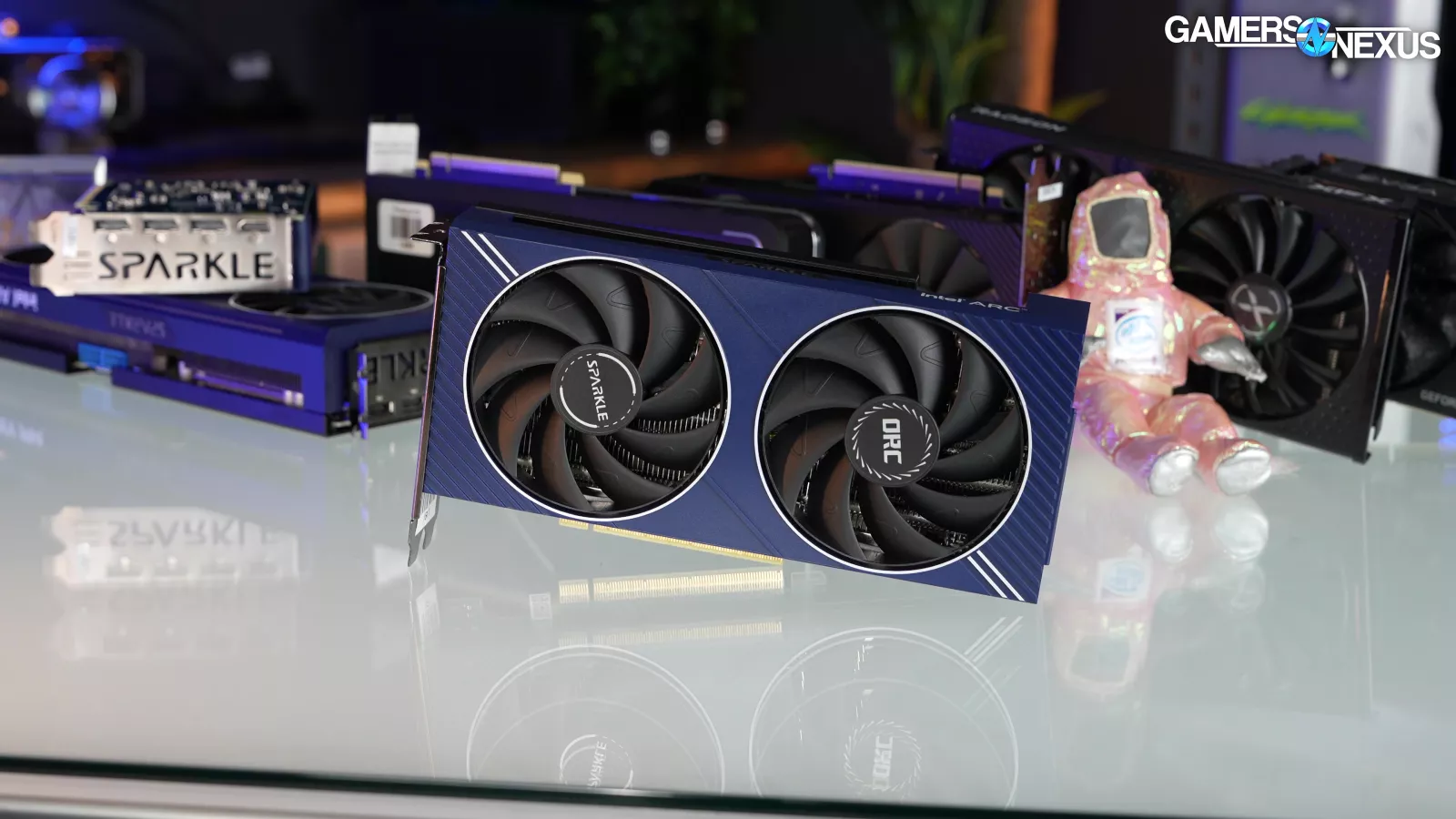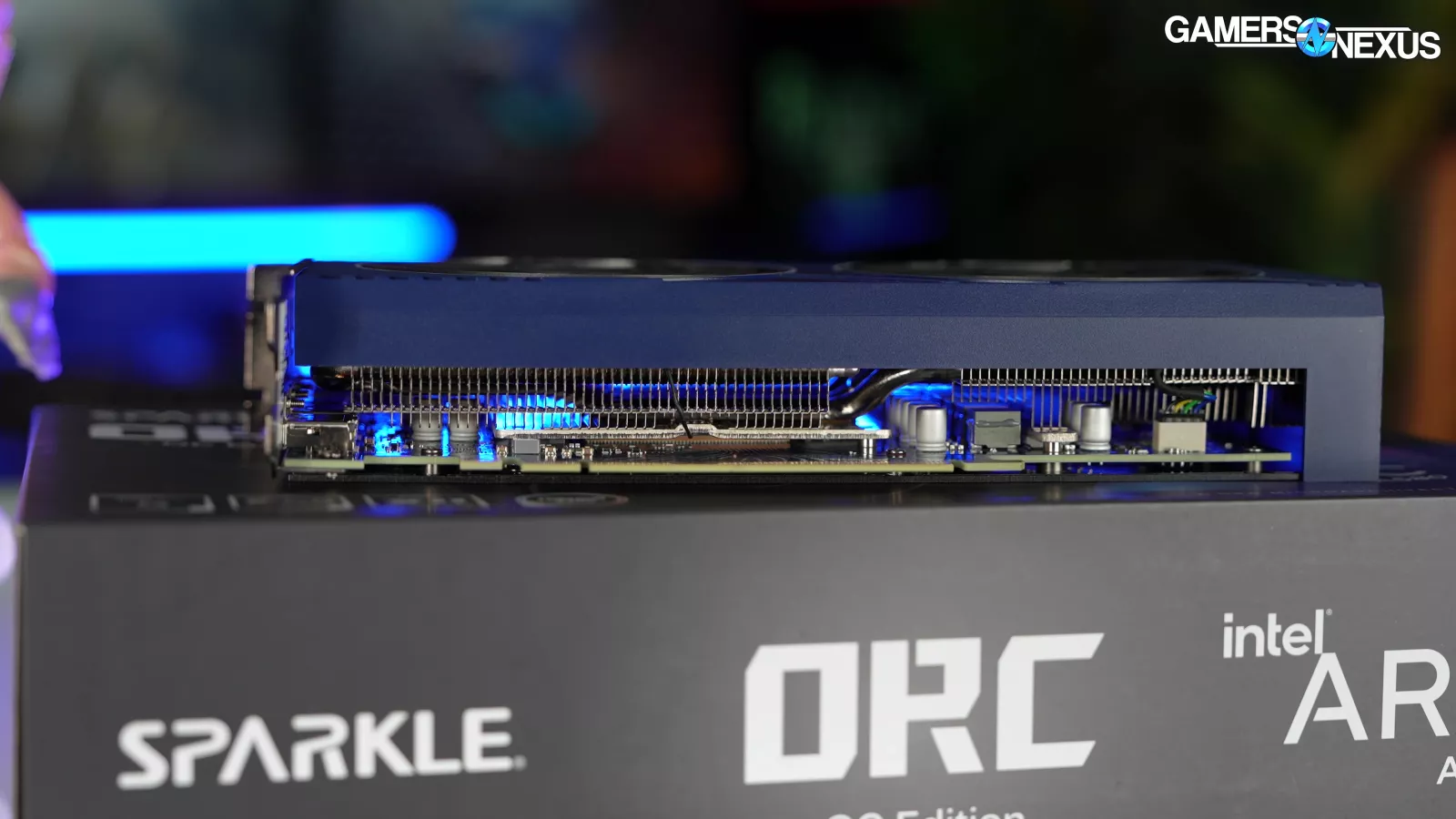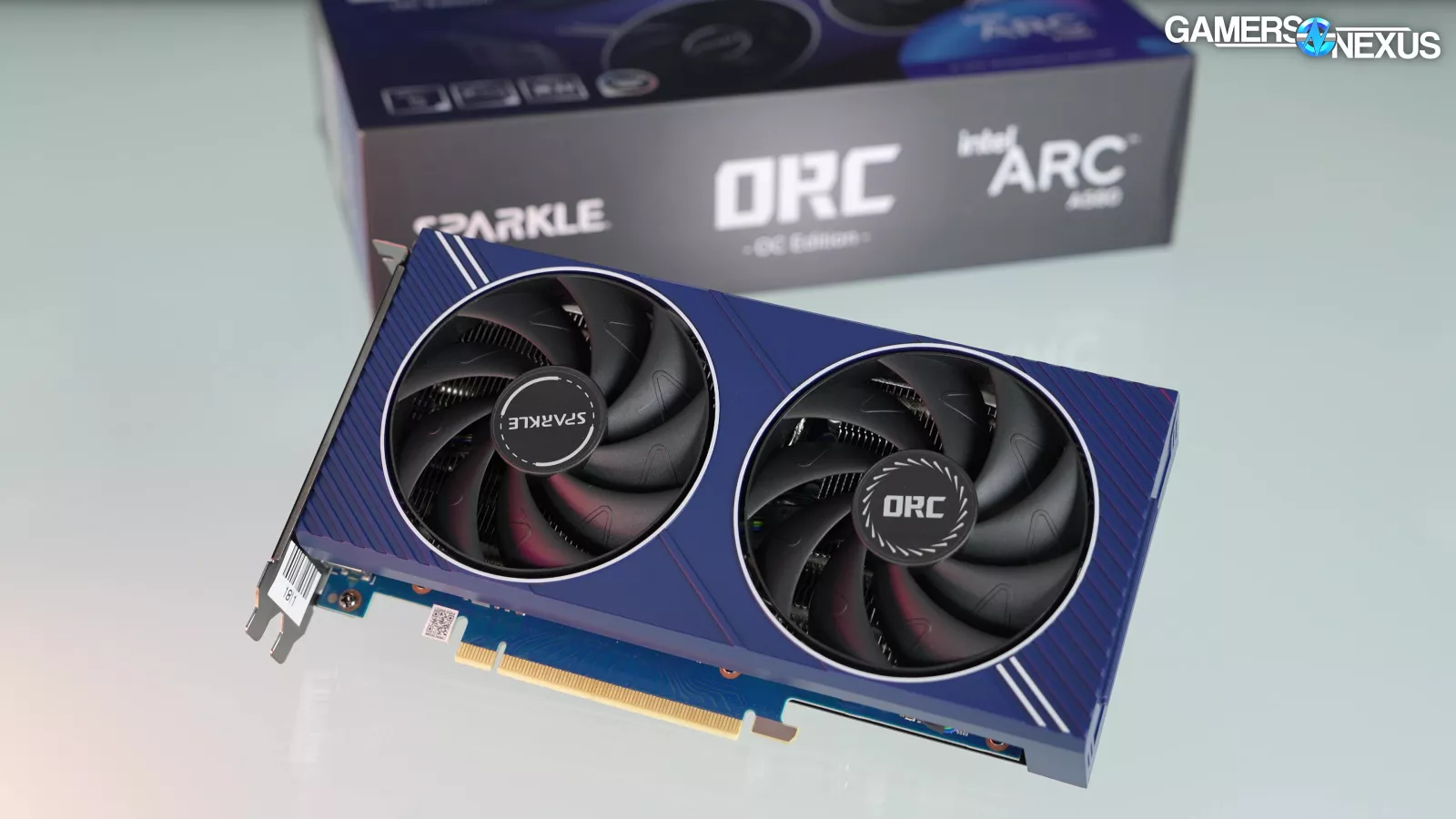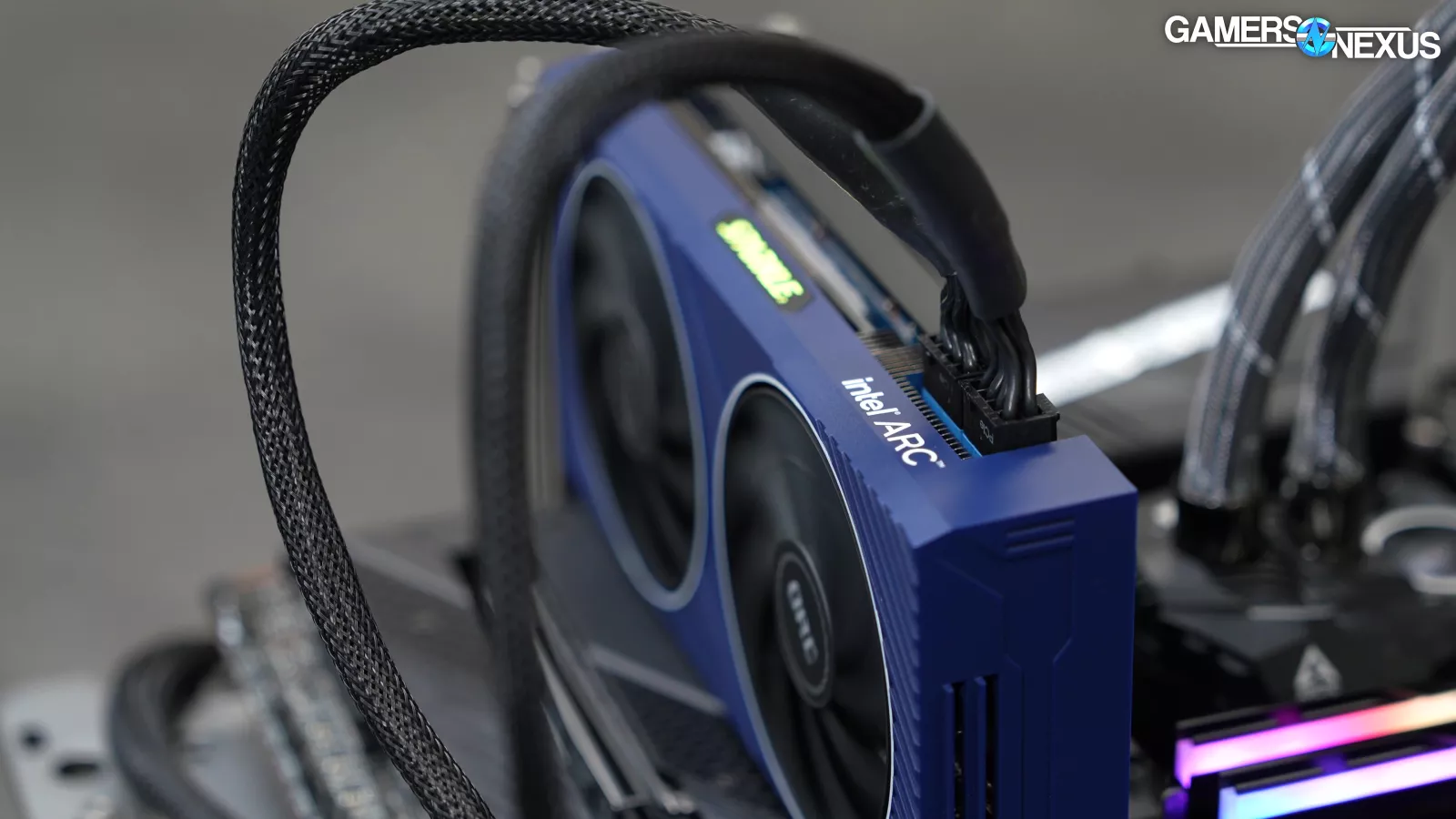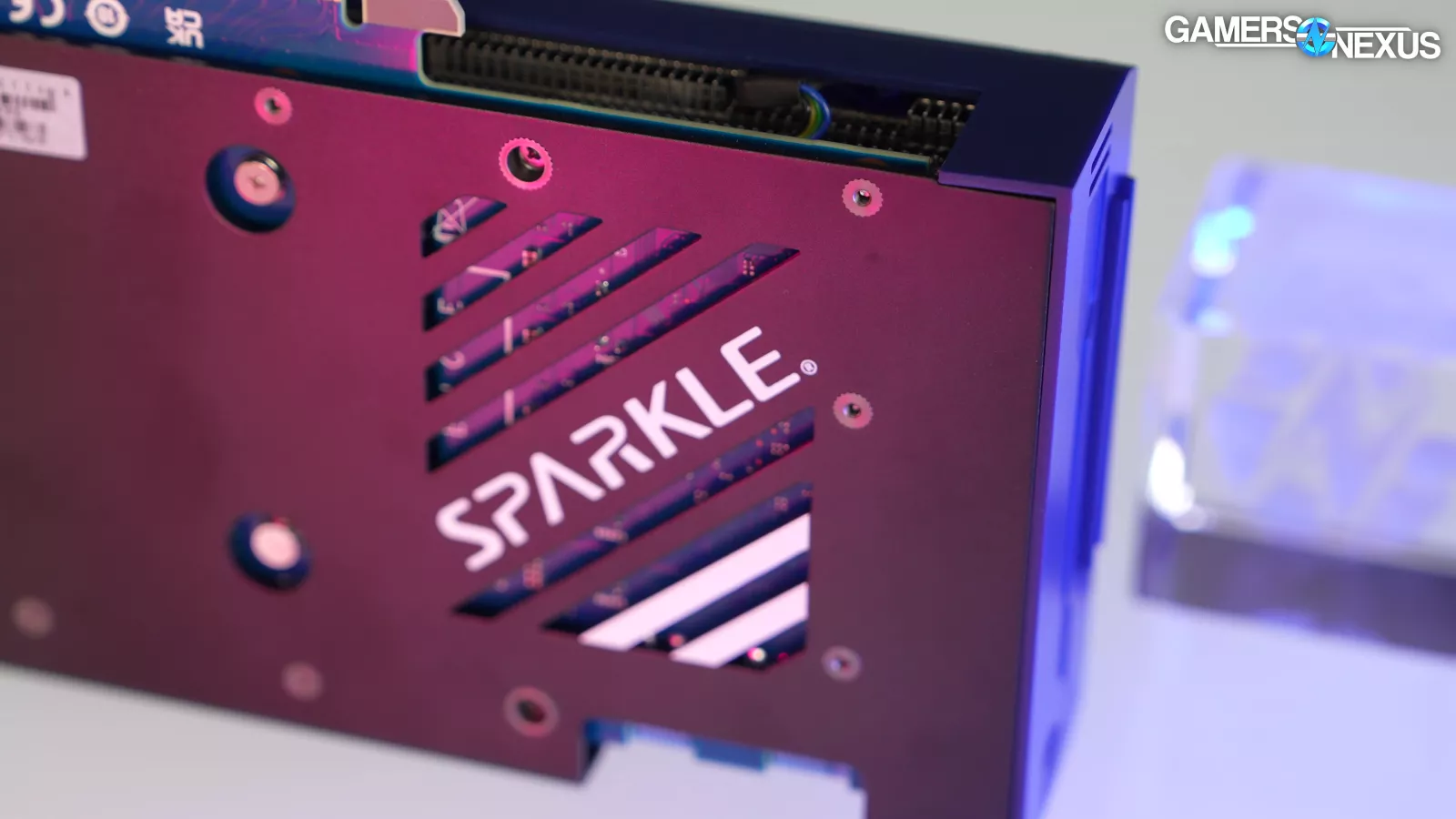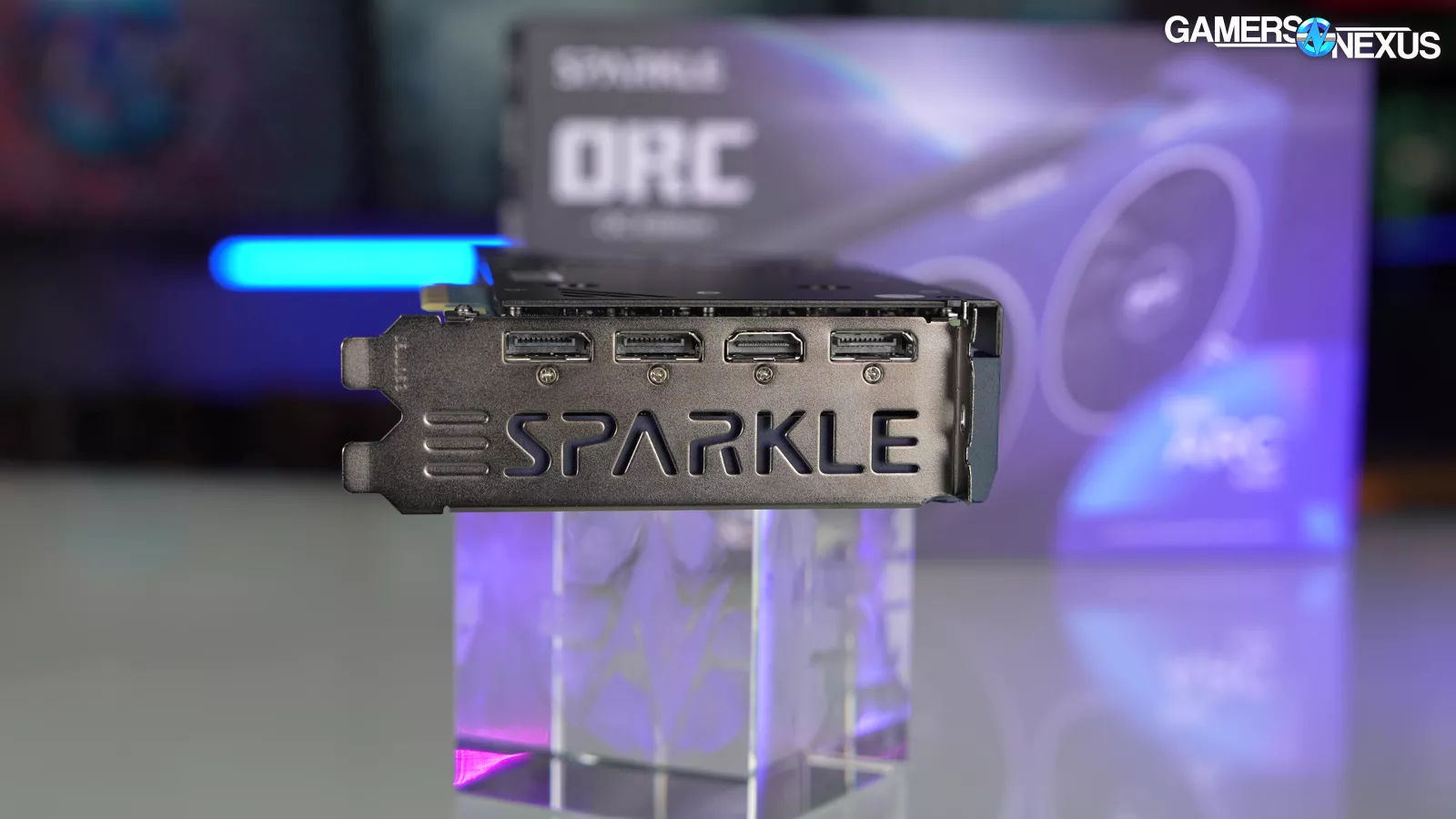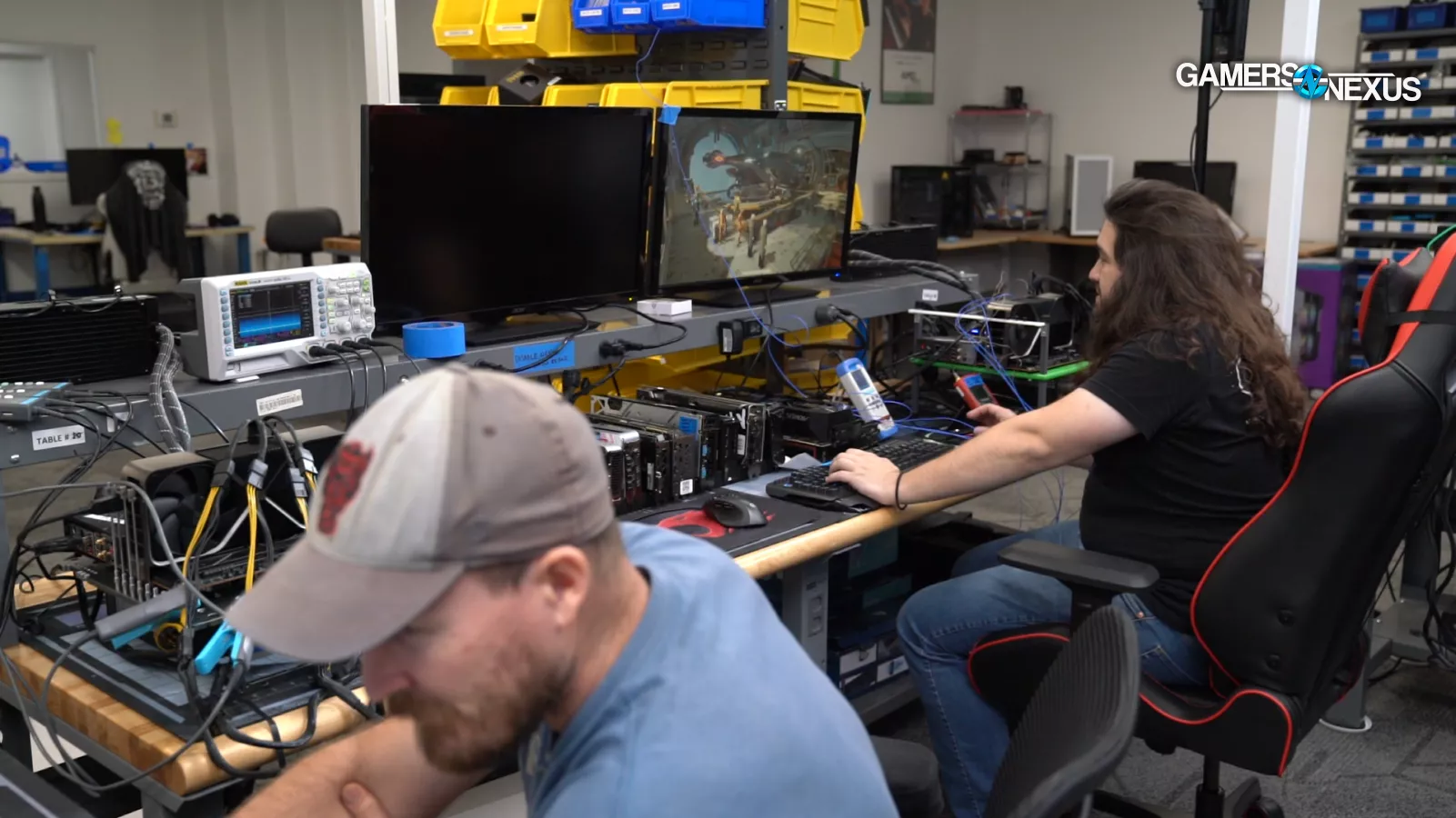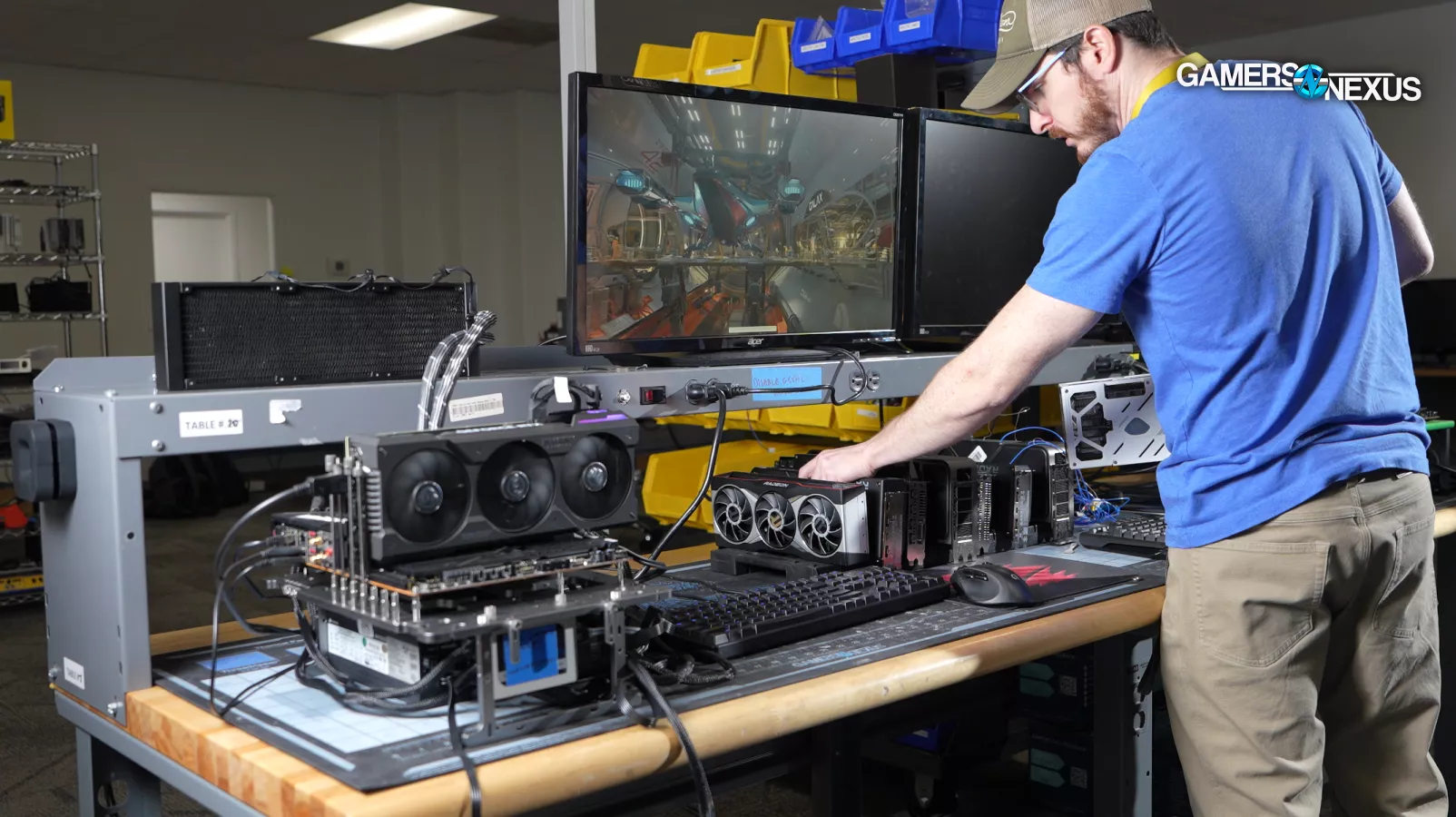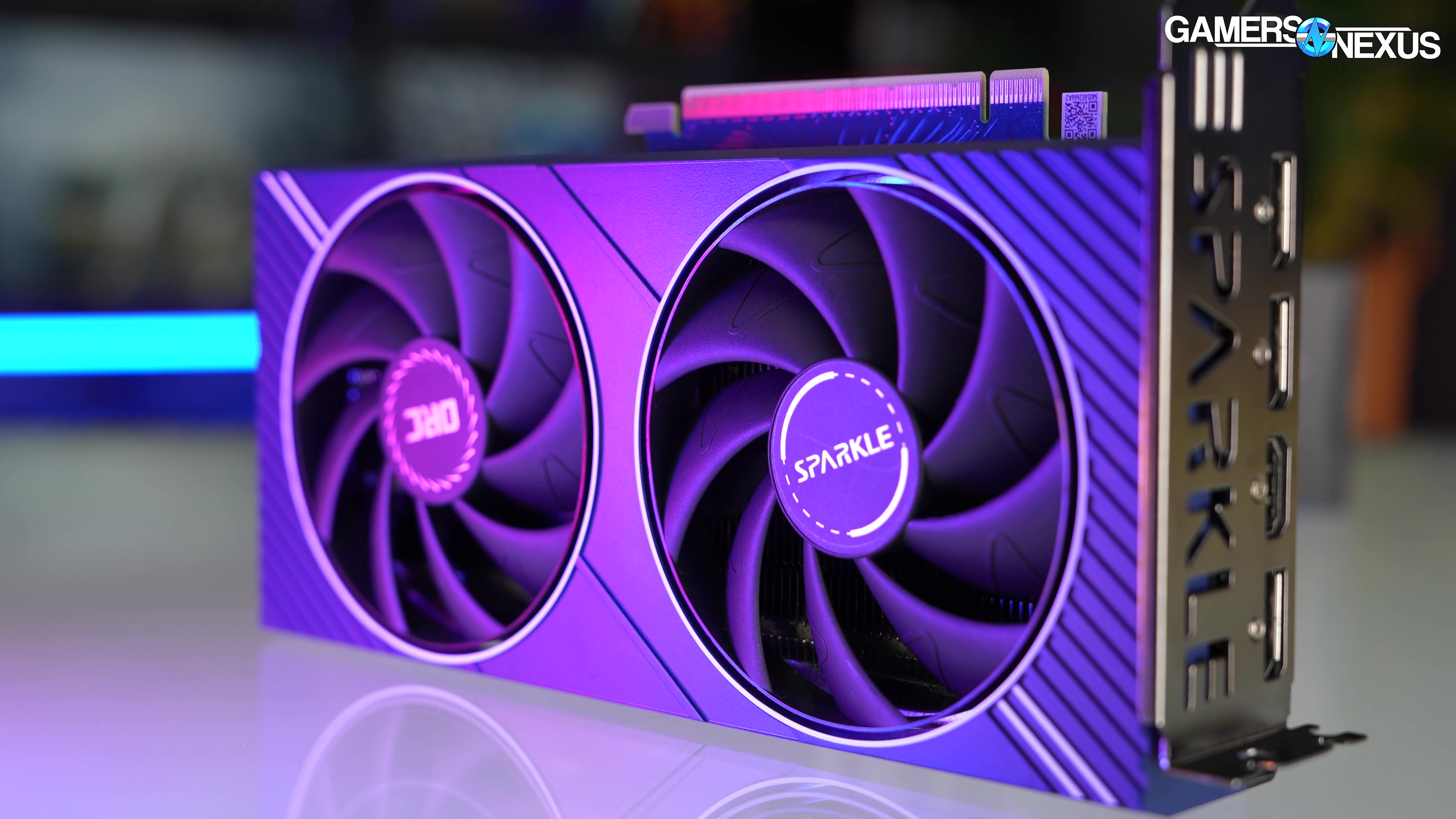
Intel Arc Goes Where NVIDIA Won't: A580 GPU Benchmarks & Review vs. A750, RX 6600, & More
Last Updated:
The Intel Arc A580 is a new affordable GPU that’s currently up against stiff competition from last-gen cards
The Highlights
- Intel’s Arc A580 is one of the only sub-$200 GPUs to hit the market in a long time
- It is a massively power-inefficient card
- Intel has made significant advancements to its drivers but still has room for improvement
- Original MSRP: $180
- Release Date: October 10, 2023

Intel Arc has some downsides, but it’s massively improved over the past year. Intel has managed to resolve many of its broken driver issues and has picked up the performance overall. Despite shedding staff, which concerns us for its longevity, the company has managed to turn the Arc launch around in a big way. But it’s competing with large players who have mountains of last-gen GPUs that they can dump for cheap, and that’s a challenge. But the Intel Arc A580 is going to try and make its mark in the budget class.
The Intel Arc A580 is a new $180 GPU -- one of the only sub-$200 GPUs to hit the market in a long time. There is one problem here, however, and it comes from within: the A750 is now around $190 at times. A $10 price gap in real-world pricing is going to be a tough one for the weaker card to win, and the Arc A750 has recently become a recommendation of ours in its price class (although, only for enthusiasts who can tolerate drivers that are late for new games and occasional crashes).
Credits
Host, Writing, Testing
Steve Burke
Testing
Mike Gaglione
Jeremy Clayton
Camera, Video Editing
Vitalii Makhnovets
Writing, Web Editing
Jimmy Thang
The A580 is an interesting card: It applies some pressure to the existing stack, but likewise, its steepest competition comes from the older AMD Radeon RX 6600 and Intel’s own A750. The RX 6600 is often around $200 these days, making it one of the fiercest nearby competitors and alternatives to the Arc A580.
NVIDIA has functionally abandoned this market -- they seem to want you to pay for game streaming indefinitely if you’re in this price class. In fact, only NVIDIA’s RTX 3050 is worth mention here, but it’s not relevant enough to re-test. Although if rumors of a 6GB 3050 are true, maybe that’ll change.
Today, we’re looking at the Intel Arc A580 Orc by Sparkle. Given it's an Orc, we expect to find bonuses to its constitution and strength.
Intel Arc A580 GPU Specs vs. A750
| GPU Specs | Intel Arc A580 | Intel Arc A750 |
| Shading Units | 3072 | 3584 |
| Cache | 8MB | 16MB |
| TDP | 175W | 225W |
| Memory Capacity | 8GB | 8GB |
| Memory Type | GDDR6 | GDDR6 |
| Memory Bus | 256-bit | 256-bit |
| TMUs | 192 | 224 |
| ROPs | 96 | 112 |
The Intel Arc A580 GPU runs 3072 shading units, an 8MB cache, and has a TDP of 175W. Memory capacity and type come out to 8GB GDDR6 on a 256-bit memory bus.
Compared to the A750, that’s a lower TDP, a reduction in shader count from 3584 units, and likewise a drop in ROPs and TMUs.
Intel Arc A580 Graphics Card Benchmarks
This testing will make use of our standardized GPU test platform that we deploy for all reviews. You can learn about our test benches and the games we run in this living document, with large parts of our methodology explained here (although the games have changed).
GN 2022-2023 GPU Test Bench & Methodology
| Part | Component | Provided By |
| CPU | Intel Core i7-12700KF Overclocked (4.9GHz P-Cores, 3.9GHz E-Cores) | Bought by GN |
| Motherboard | MSI Z690 Unify | MSI |
| RAM | DDR5-6000 G.Skill Trident Z (manually tightened timings) | G.Skill |
| Cooler | Arctic Liquid Freezer II 360 @ 100% Fan Speed | Bought by GN |
| PSU | EVGA 1600W T2 Supernova Corsair AX1600i | EVGA Corsair |
| OS | Windows 11 | Bought by GN |
Baldur’s Gate 3 GPU Benchmarks
Baldur's Gate 3 1080p/Ultra Graphics Card Comparison
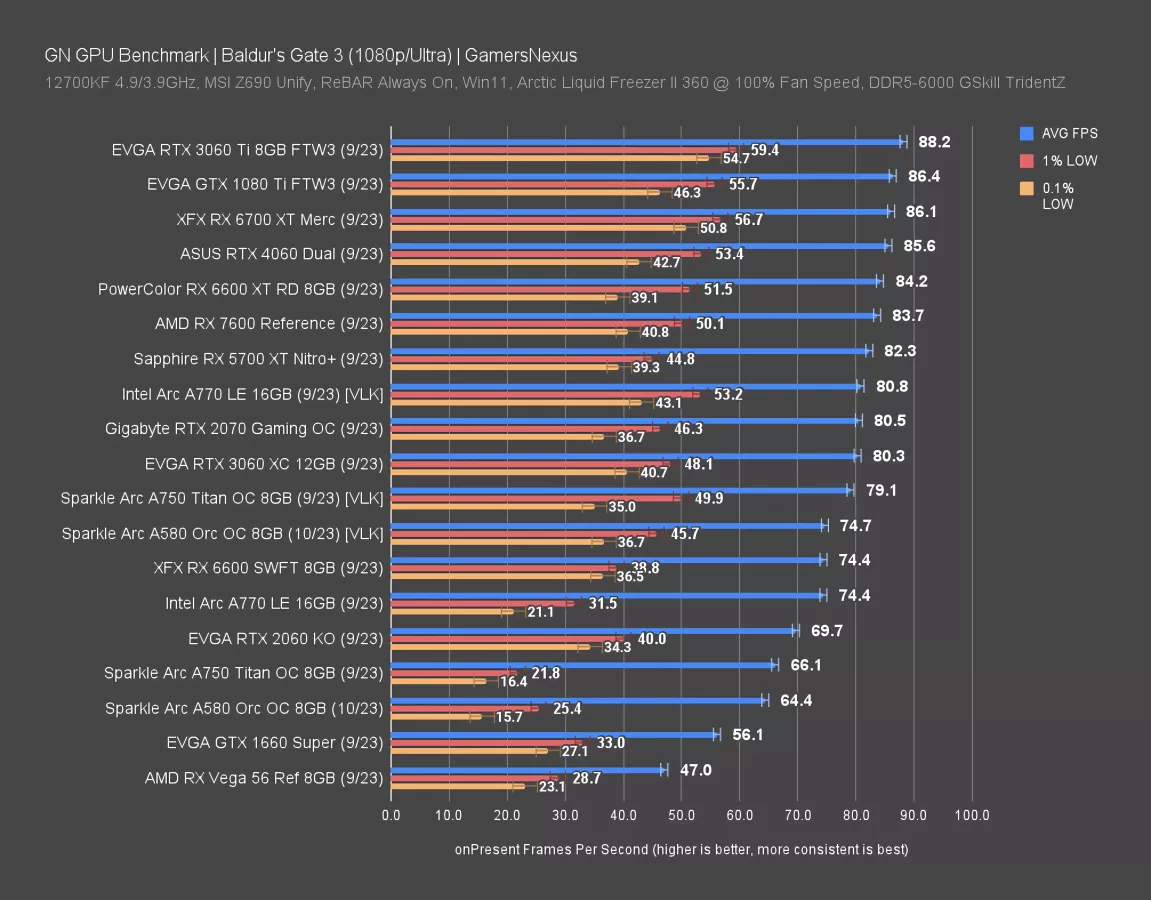
Baldur’s Gate 3 is up first. This is one of the newest games to our test suite, and it works great for cards that are below the $400 price mark.
As we settle into this chart, remember that Intel had difficulty running Baldur’s Gate 3 with the DirectX API. We talked about this in our Baldur’s Gate GPU review. Vulkan is significantly better on Arc and in ways which weren’t replicated on other cards. Arc had serious frame pacing problems with DirectX.
We’ll start with a like-for-like comparison: The A580 with Vulkan -- its best and most appropriate use case -- allowed the A750 with Vulkan a lead of about 5-6%. We also retested this with the newest drivers and had the same result.
Also like-for-like, the DirectX result for the A580 had it below the RTX 2060 and RX 6600, with the 6600 carrying a significant lead in low performance.
Everything in the 80s for FPS is hitting a CPU bind at some point.
Baldur's Gate 3 1440p/Ultra Graphics Card Comparison
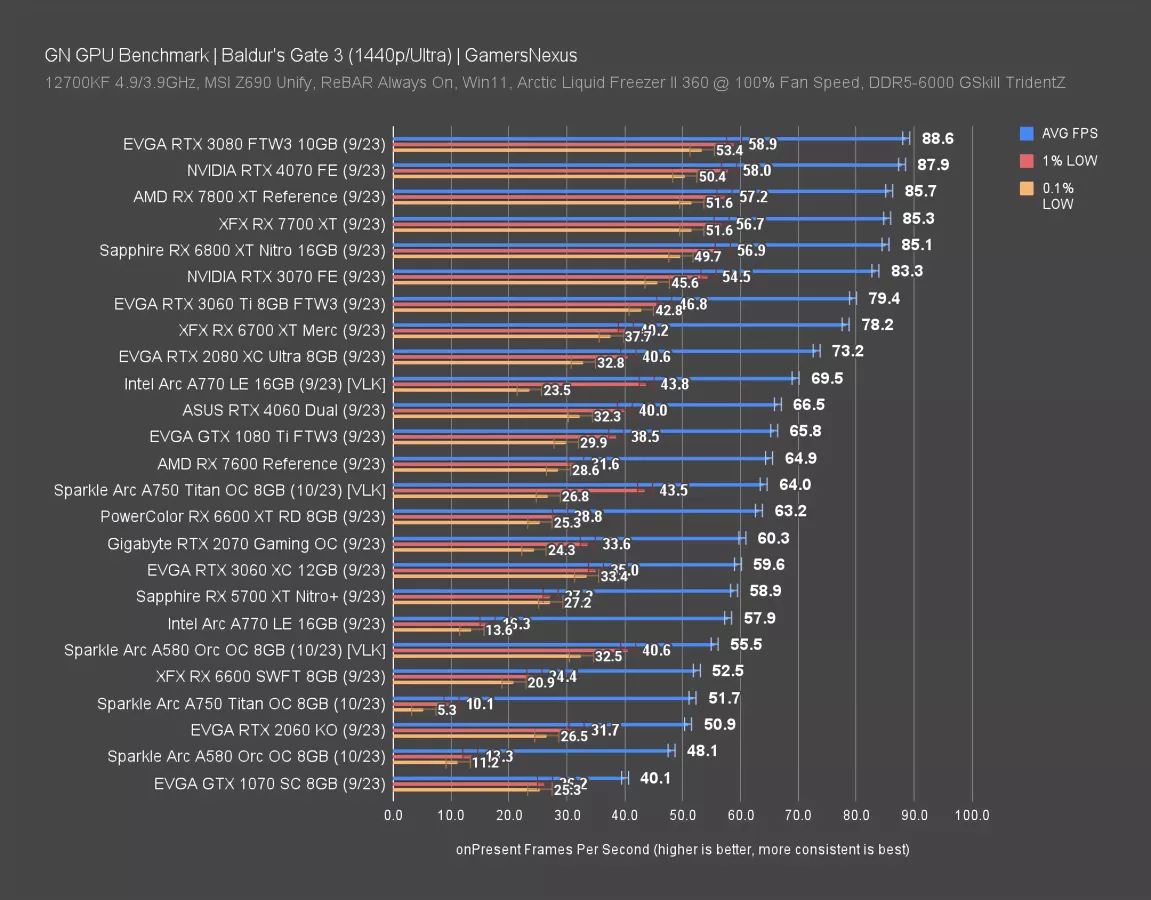
In Baldur’s Gate 3 at 1440p, the Intel A580 Orc ran at 56FPS AVG with Vulkan. That has the A580 ahead of the RX 6600 SWFT. The lead is mostly a technicality in AVG FPS, but the lows are better -- but this is Vulkan. In Dx11, a truer like-for-like, the 6600 leads the A580 by 9%.
Let’s stick to a like-for-like with Vulkan: The A750 ran at 64FPS AVG, leading the A580’s 56FPS AVG result by 15%. That’s a more significant gap than we saw at 1080p, which is because the A750 was occasionally brushing against a CPU limit.

Starfield GPU Benchmarks
Starfield Graphics Card Comparison at 1080p/High
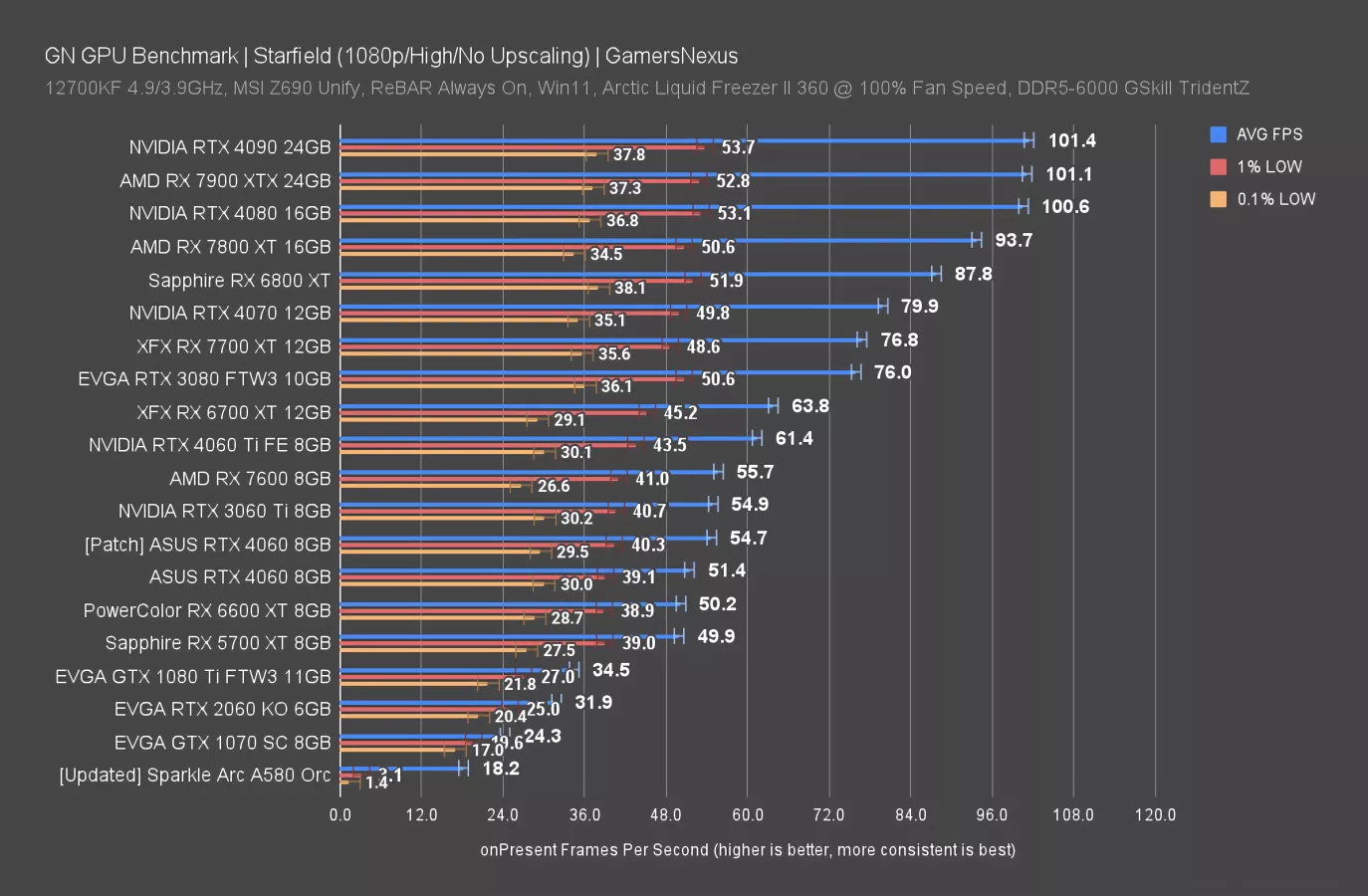
Starfield went terribly for Intel. We used the drivers that claimed triple-digit uplift for Arc, but considering the baseline was literally not working at all, maybe that’s an easy uplift to hit. In our testing, we observed 18FPS AVG and lows that were completely unplayable. The game was a stuttery disaster. Comparisons don’t matter here - it’s just broken right now. Maybe it’ll work better soon, as Intel has noted it is still working on improvements here.
Total War: Warhammer 3 GPU Benchmarks
Total War: Warhammer 3 1080p/High Dx11 Tests
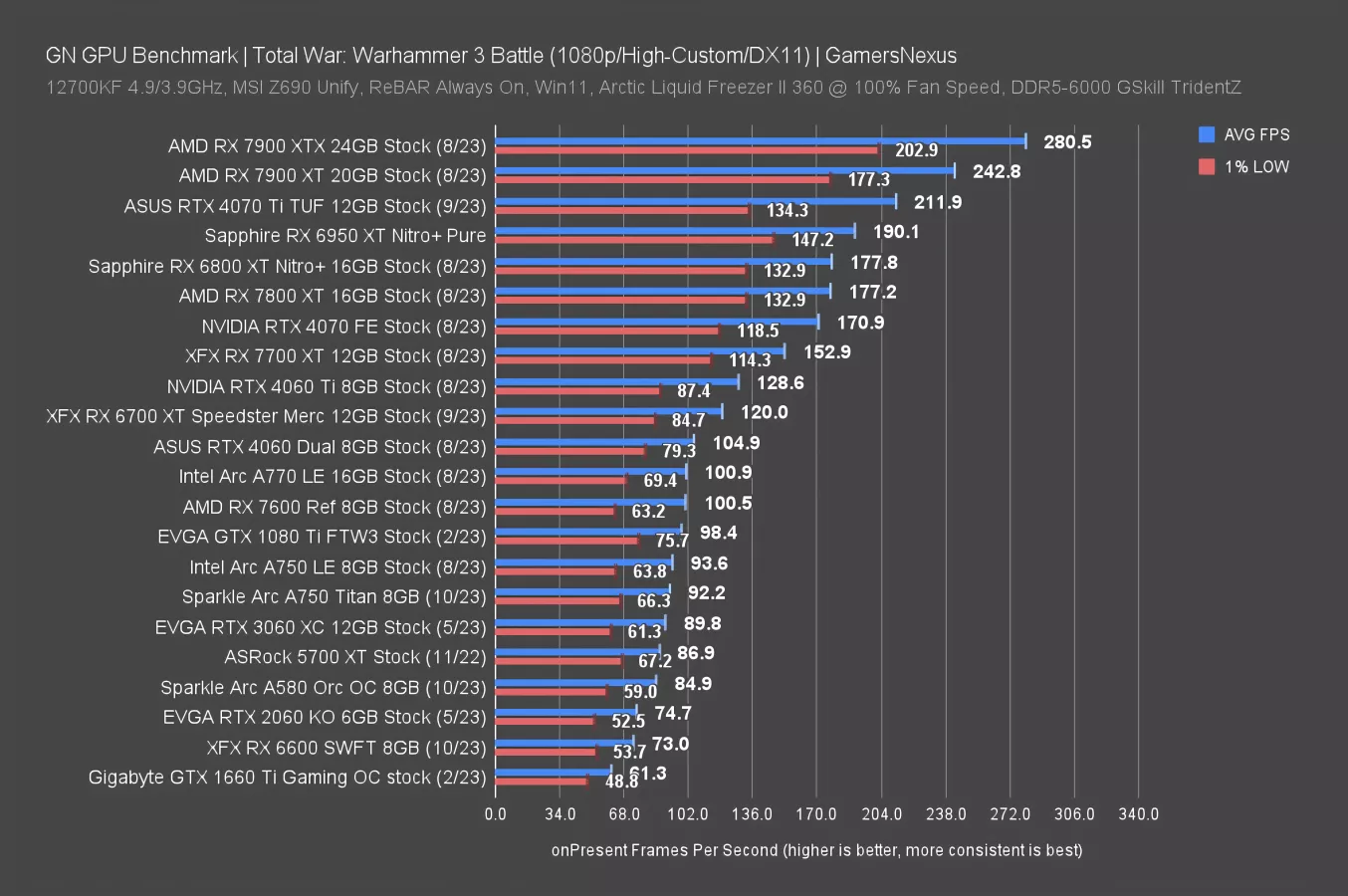
In Total War: Warhammer 3 -- just before we move to PHARAOH soon -- the game ran at 85FPS AVG on the A580. That has the A750 Sparkle card about 8.5% ahead of the new A580. Lows are scaling as we’d expect with the average. Depending on the price at the time you’re buying, if they’re further apart, it may be worth going for the A580. But if these cards are within $10-$20 of each other, the A750 appears worthwhile.
The A580 is ahead of the older RTX 2060, but given the importance of the 2060’s former $300 positioning for the KO model, that’s a good spot for the A580 to be in. Compared to the RX 6600, the A580 leads by 16% in AVG FPS, with lows similar.
To look at one price class up, the RX 7600 -- these days $230-$250 -- is at 101FPS AVG. That has it leading the A580 by 18% while costing about 33% more on average. The AMD RX 7600 is in a different class for performance in general.
Total Warhammer 3 - 1440p Video Card Benchmarks
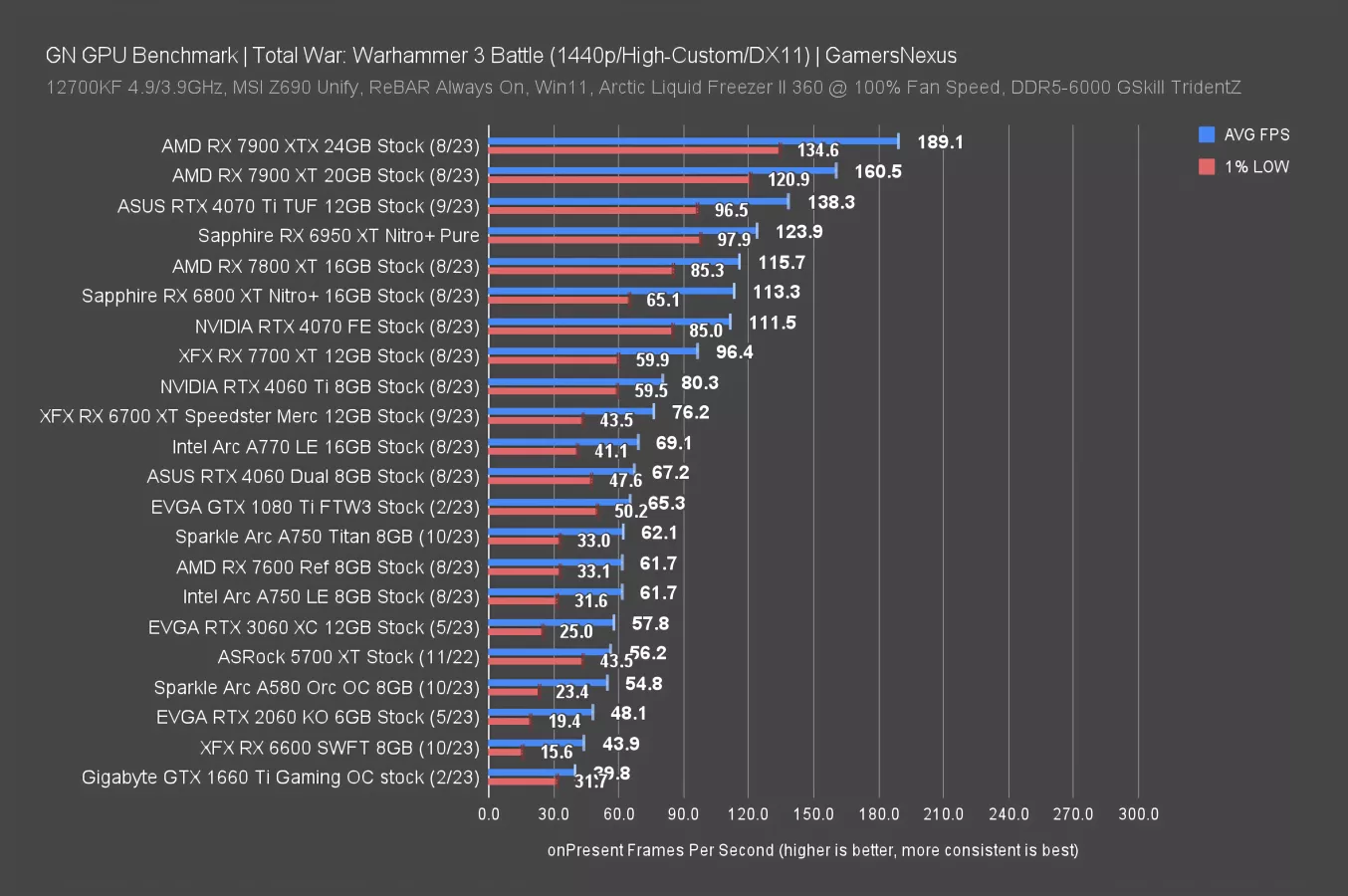
At 1440p, what we want to know is whether the scaling remains the same. The A580 leads the RTX 2060 by 14% here, almost identical to the 1080p lead. Against the RX 6600, it’s 25% ahead -- a larger gap than the 16% lead at 1080p. The Intel Arc card is doing relatively well scaling as resolution increases, although it’s still ultimately more of a 1080p card. But that’s useful information to have.
The A750 Titan meanwhile leads by about 13%, up at 62FPS AVG. The 1080 Ti remains a familiar face here, except with significantly improved lows over some of its immediate neighbors. Looking between the A580 and A750 Titan, we land on the RX 7600 at about 62FPS AVG -- the same 13% lead over the A580.
Shadow of the Tomb Raider GPU Benchmarks
Shadow of the Tomb Raider Benchmarks (1080p/High)
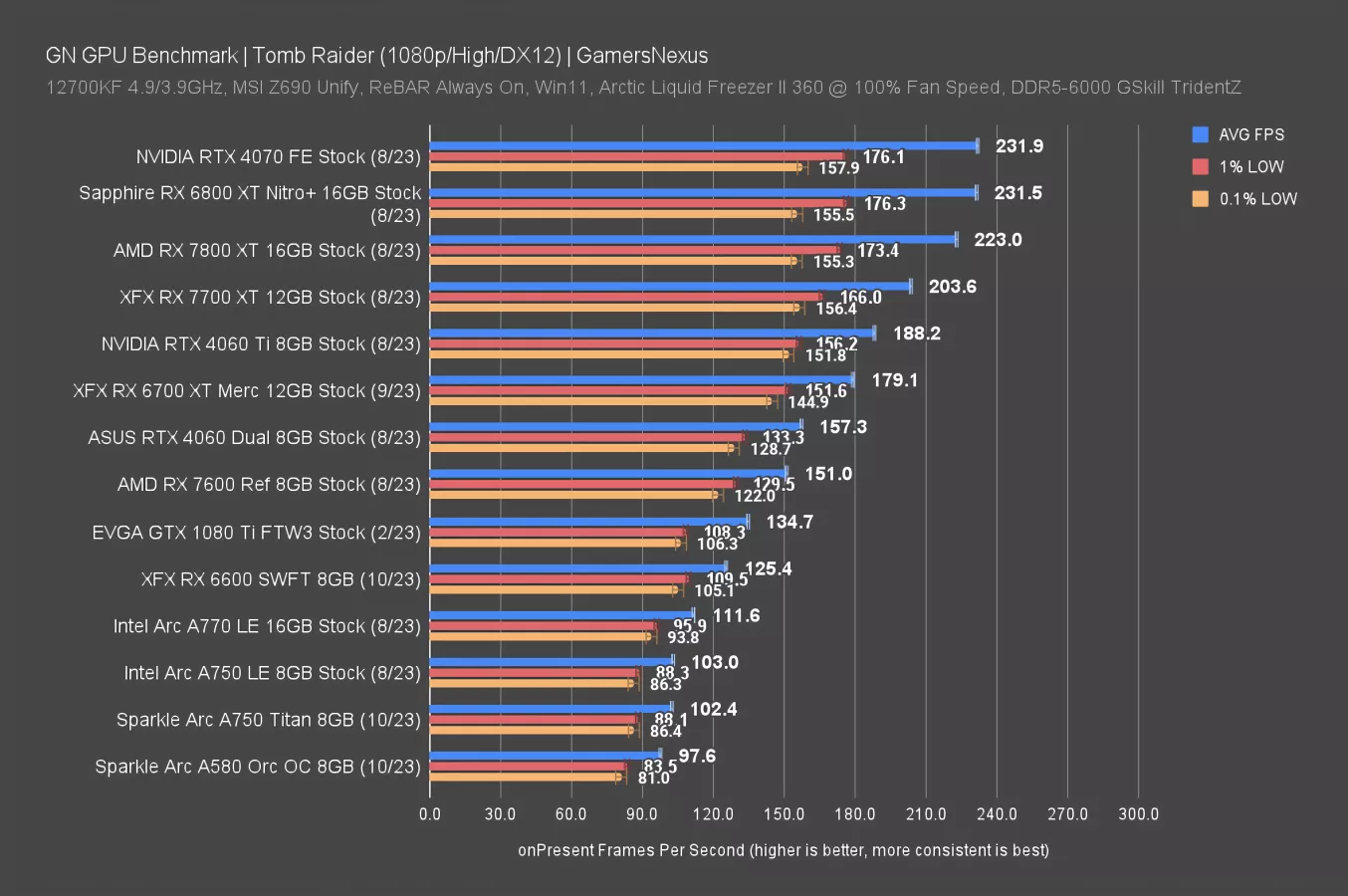
In Shadow of the Tomb Raider at 1080p, the A580 ran at 98FPS AVG, allowing the A750 Titan to establish a 5% lead over the newer A580. If this were more consistently the gap, then the cheaper card would be the clear winner. The RX 6600 leads both, with its result at 125FPS AVG, gapping the A580 by 28%. As long as there’s price proximity between the two, at least in this game, the 6600 would be the clear choice.
For more expensive comparisons, the RX 7600 pushes further ahead with a 54% advantage. The RTX 4060’s 157FPS AVG result is a little further ahead still.
Please note that everything at or above 230FPS AVG is CPU-bound since we’re at 1080p, so those results aren’t comparable. We’ve removed cards like the 7900 XTX, 7900 XT, 4070 Ti, and similar.
Shadow of the Tomb Raider (1440p/High)

At 1440p, the A580’s 74FPS AVG had it about 5FPS behind the A750, giving the A750 a 6.5% lead. That’s more than we saw at 1080p, so they’re getting more distant -- but not in a relevant way. The RX 6600’s 83FPS AVG has it 12% ahead of the A580 here, so if they’re the same price, the 6600 would be the better buy. The $20 gap gives us more to consider and we’ll need the full picture of all games to make a determination at the end.
Spending around $100 more would put you 35% ahead with the RX 7600, which also pulls up its lows -- although the A580’s lows in this game aren’t a problem. Going to the 4060 would increase that gap by a couple percentage points, but increase the dollar amount more significantly.
Final Fantasy XIV GPU Benchmarks
FFXIV 1080p/Maximum Graphics Card Comparison

In Final Fantasy XIV at 1080p, the A580 finds its place at a high framerate in a less intensive game. The 154FPS AVG result positions it about 5.5% ahead of the RTX 2060. You shouldn’t change from the 2060 to the A580, but it gives us a good idea of industry trends in this price class.
The RX 6600 is about tied with the A580 in this one, although the A580 pushes better lows -- we’ve noticed that AMD cards, in general, run disproportionately low for 1% in this game. It’s not bad or particularly stuttery, but definitely worse than what we measured on Intel.
The A750 leads the A580 by almost 8% here, a little more than we’ve seen in some of these games. As for the 7600, its 20% leadership puts it in an entirely different class of card -- but so does the price tag. That or the 4060 would be the next logical major step-up.
We’re CPU-bound at 1080p starting at the 4070, so we removed everything else.
Final Fantasy XIV - 1440p Benchmarks
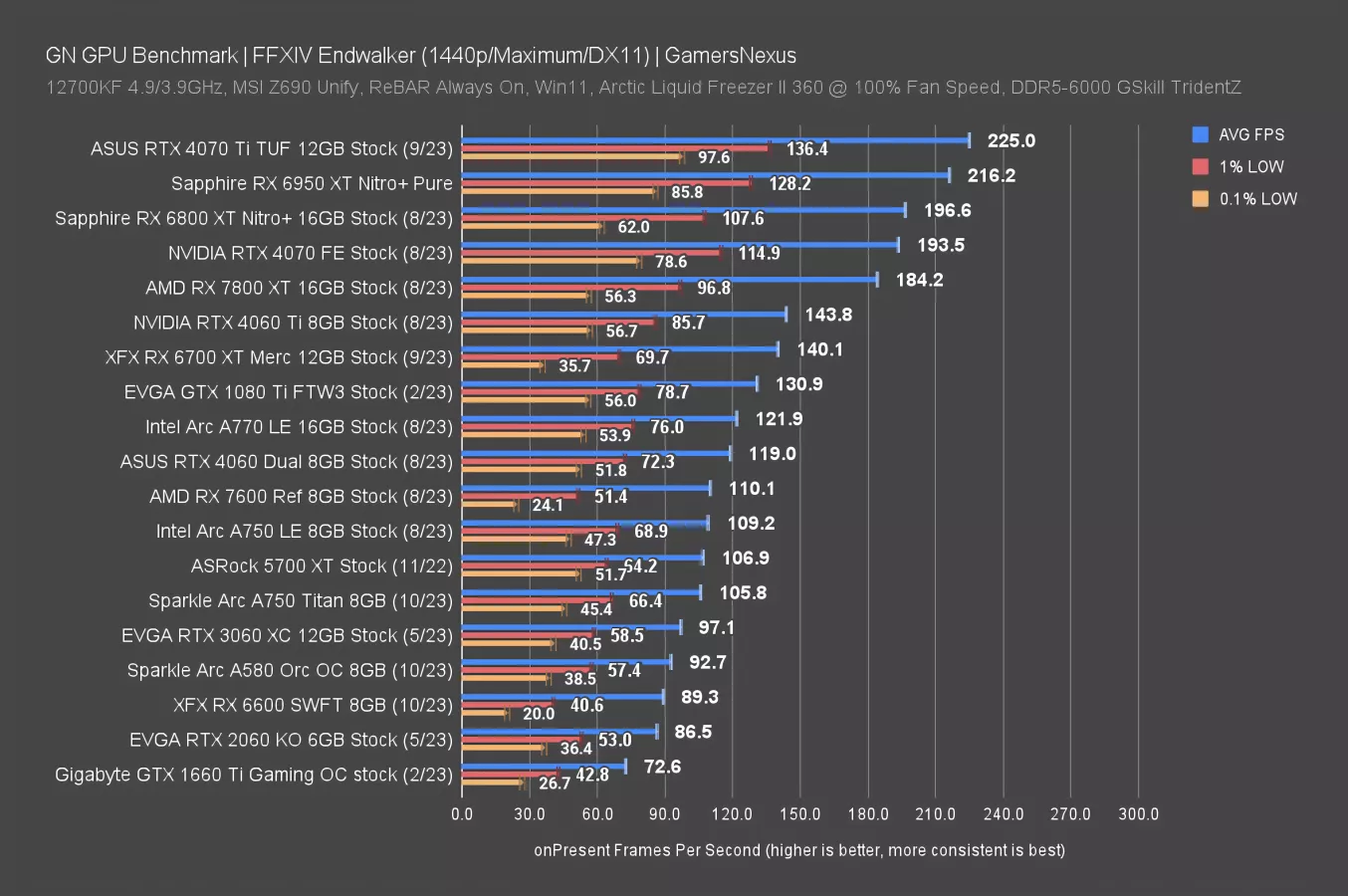
1440p is next. The A580 can still play Final Fantasy at this resolution, landing at 93FPS AVG. That has it just barely ahead of the 6600 in AVG, more in lows, and still about 7% ahead of the RTX 2060. Spending more for the A750 would get you an increase of 14%, with the 7600 reducing its lead to about 19% -- not much of a change and mostly within error.
Horizon Zero Dawn GPU Benchmarks
Horizon Zero Dawn (1440p/Quality)

Horizon Zero Dawn is next. At 1440p, the A580’s 73FPS AVG allowed the A750 Titan a lead of about 7-8% in AVG FPS. The RX 6600 is technically behind the A580, but they’re well within run-to-run variance. Even the lows are about the same, rendering the RX 6600 and A580 functionally equivalent in our benchmarking here. The A580’s lead over the 2060 is 8-9% here, again showing that it’s positioned as one of the more proper successors given the price reduction and slight performance boost -- but it’s a generation later than we’d like to see, and the same goes for Intel, which famously got stalled for its Arc launch.
F1 2022 GPU Benchmarks
F1 22 (1080p/Ultra-Custom)
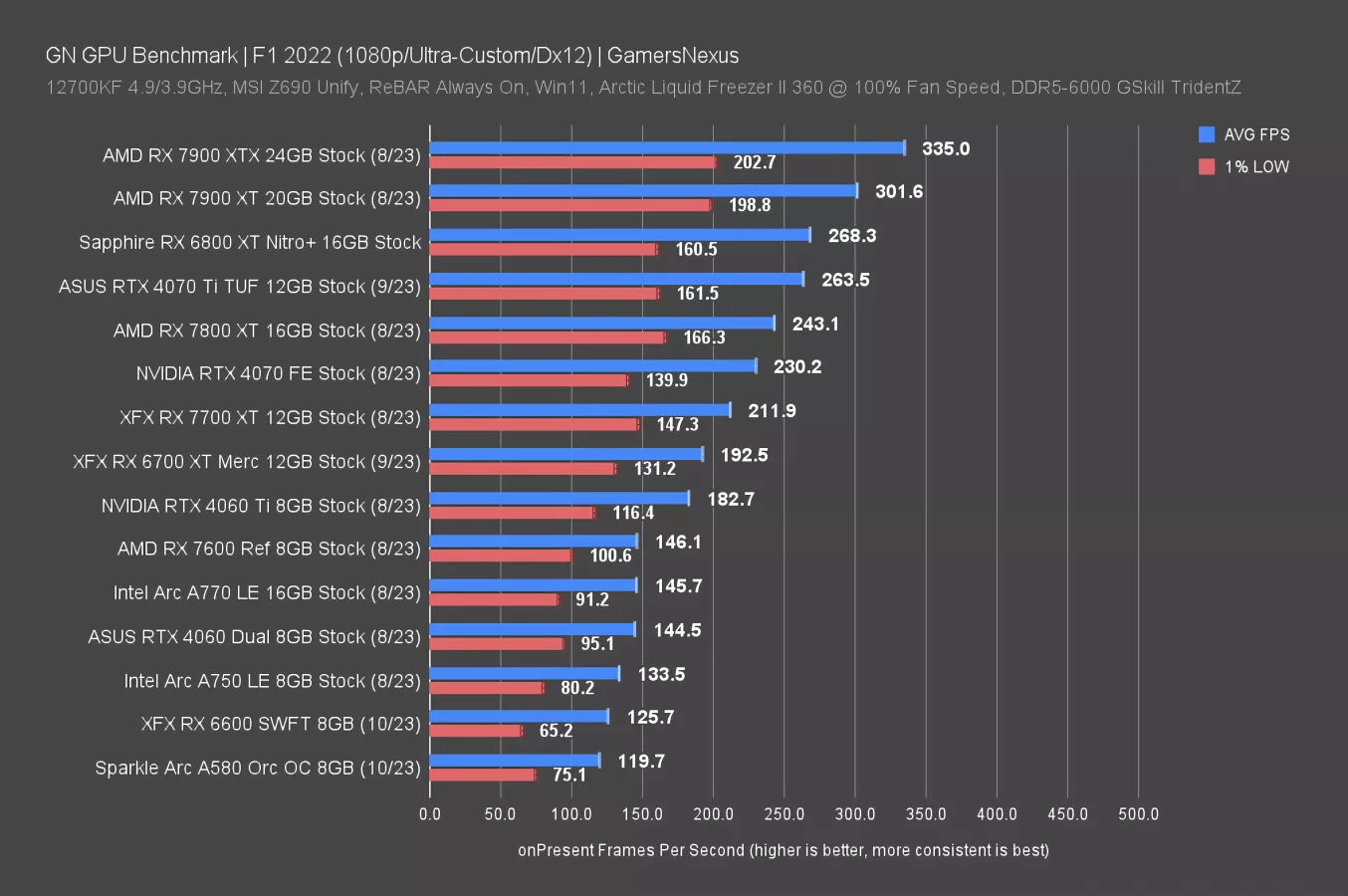
In F1 2022 at 1080p, the Intel A580 ran at 120FPS AVG, with the freshly retested RX 6600 at 126FPS AVG -- a lead of 5% in AVG FPS, although a bit behind in 1% lows. The A750 was 12% ahead in this test, with the RX 7600 22% ahead of the A580.
F1 22 (1440p/Ultra-Custom)
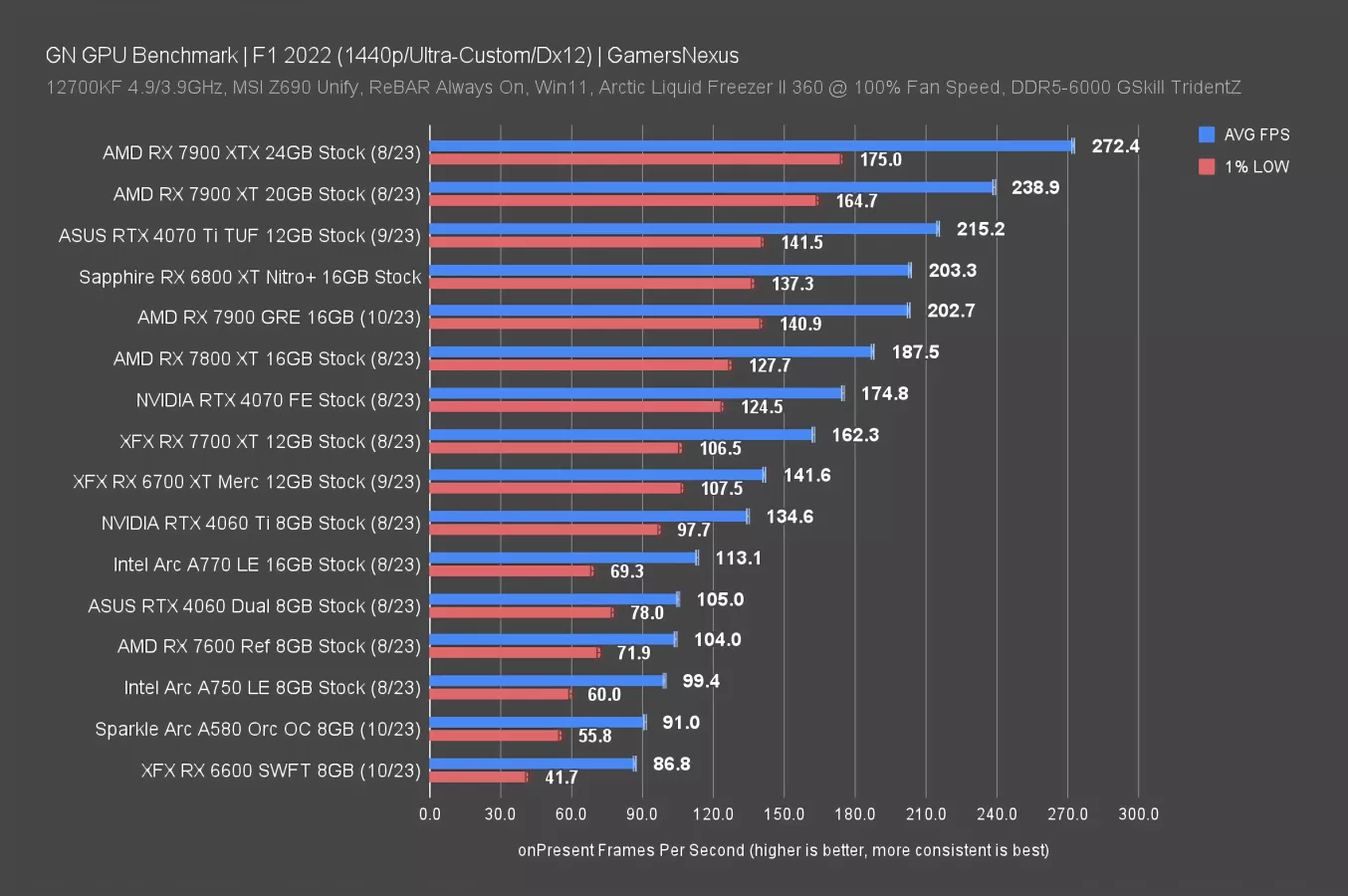
At 1440p, the A580 falls to 91FPS AVG, with the A750 now 9% ahead. The RX 6600 is behind the A580 here, allowing the new Intel GPU a lead of 4.8%. They’ve flipped spots with the resolution increase.
Intel Arc A580 Ray Tracing Benchmarks
We’ll look at some quick ray tracing numbers to close things out on the gaming side.
Shadow of the Tomb Raider (Ray Tracing)
1080p/Highest RTX
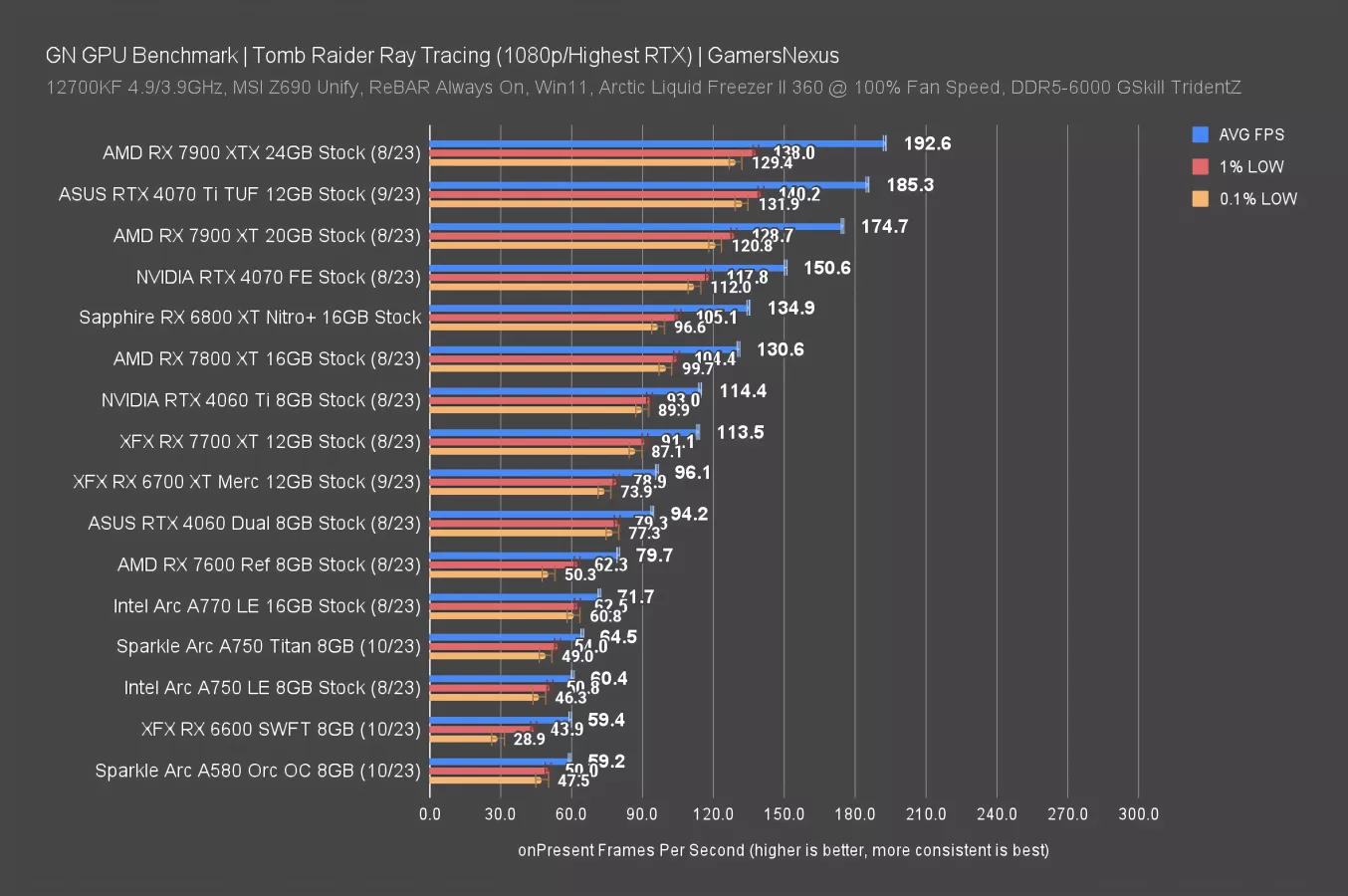
In Tomb Raider with RT Shadows, the Arc A580 managed about 60FPS AVG at 1080p with the highest RT settings. Considering the equivalence with the 6600 -- and close proximity to the recently re-tested A750 Titan -- we’d say this is great relative positioning for the A580. It allows the A750 Titan (again, with new data) a lead of 9% -- but that’s similar to what we saw in rasterization, so given the A580’s cut-down spec, that’s not bad.
1440p/Highest RTX
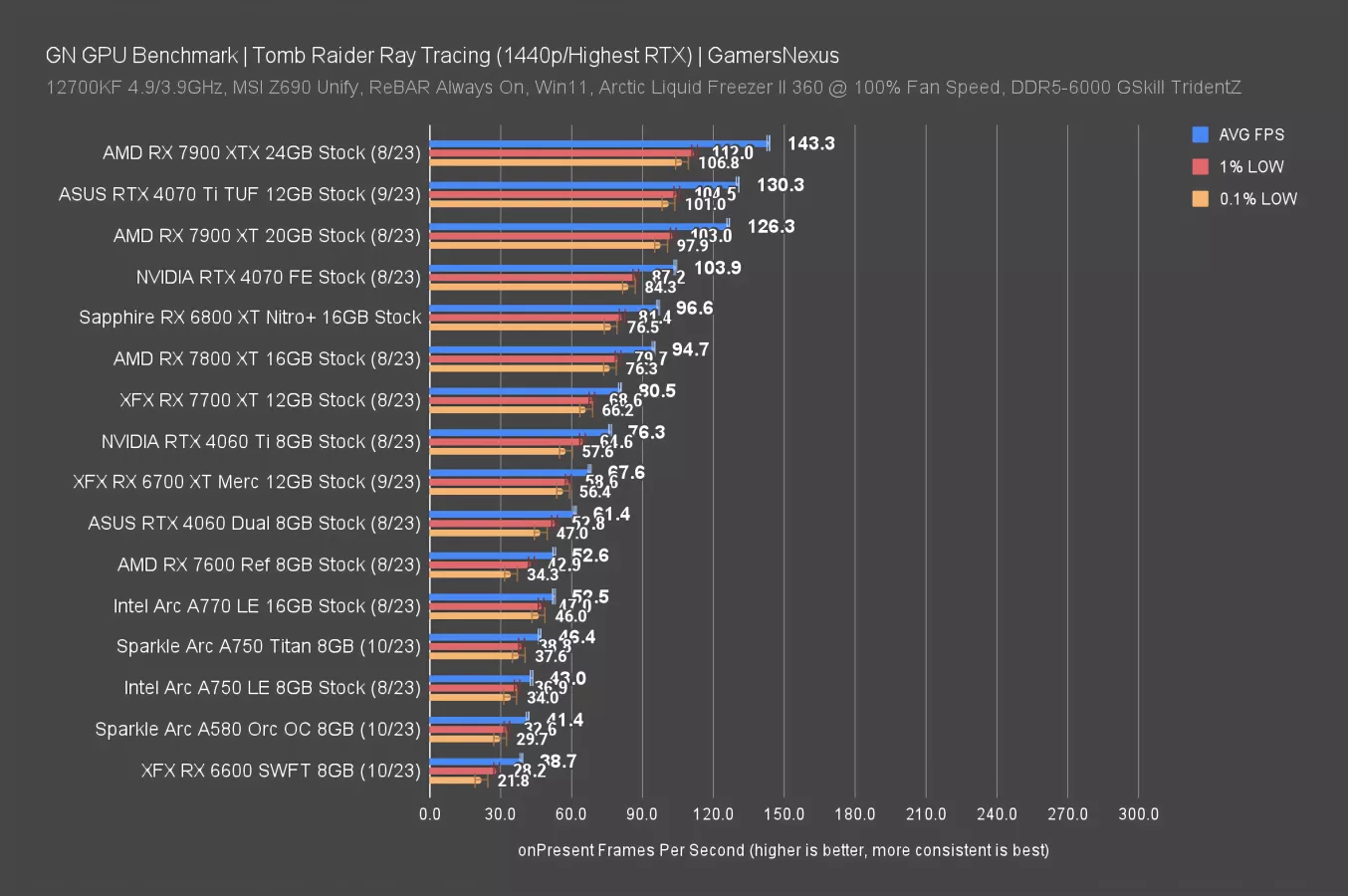
At 1440p, the A580 led the RX 6600 once again. It’s proving itself here as compared to earlier results. The A750 Titan manages a 5FPS AVG lead, but overall, the A580 is doing relatively well.
F1 2022 (Ray Tracing)
1080p/Ultra-Custom
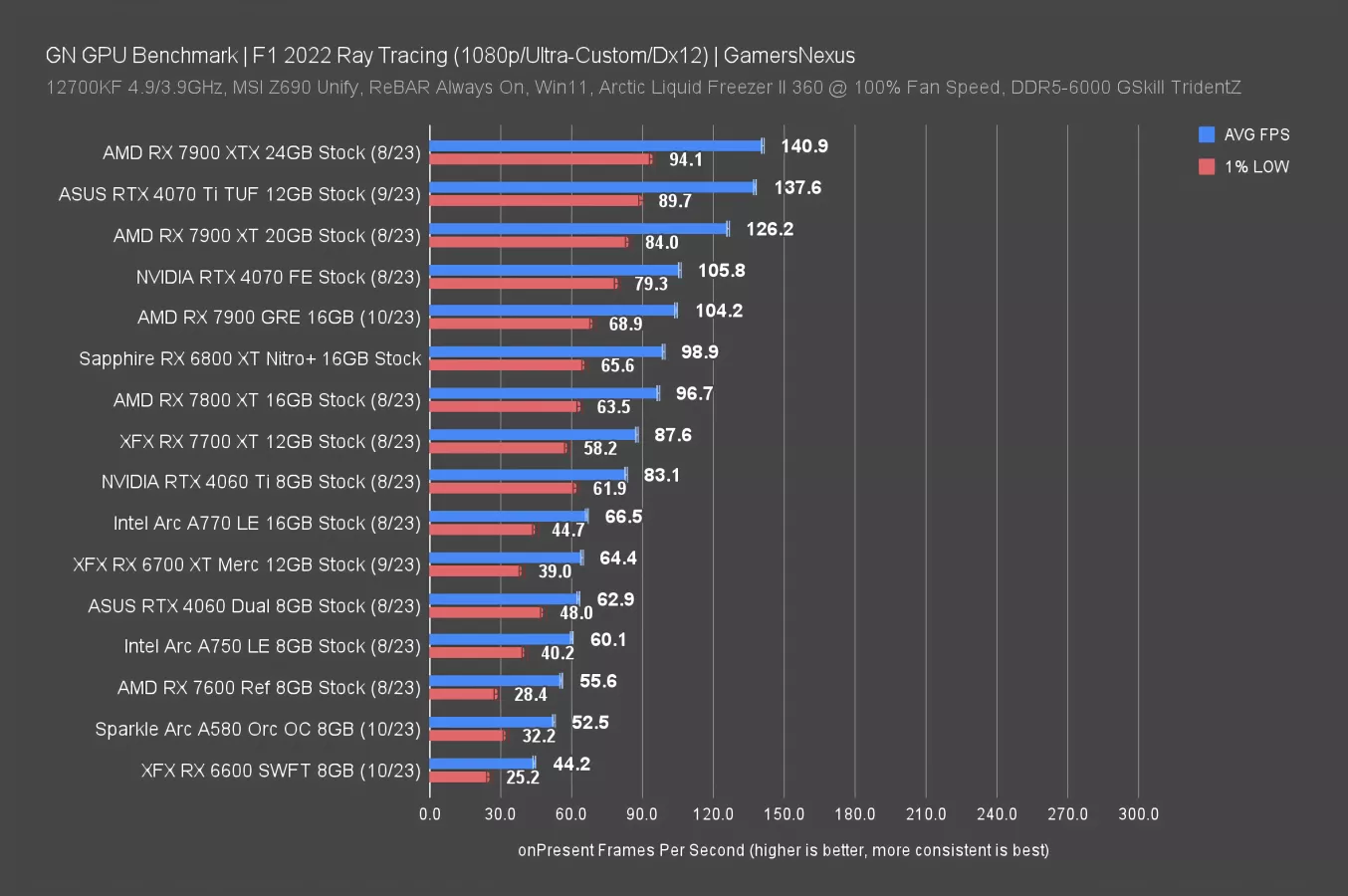
In F1 2022 with RT enabled, the A580 once again performed relatively well: It’s encroaching on the RX 7600. The A750 has a 14% lead, similar to what we saw in some rasterization tests. The RX 6600 remains behind the A580, giving it an advantage in this particular test with RT on.
Thermal & Power Benchmarks
Intel's Arc frequency logging is still unreliable, but we can at least focus on thermals and power. We'll use external logging utilities for many aspects of this, although GPU-Z is reliable for thermals.
Intel Arc A580 Thermals
Finally, we’ll run some thermal tests. This is contingent first on the power that the silicon pulls, and second on how good the cooler from the board partner is -- that’d be Sparkle’s job.
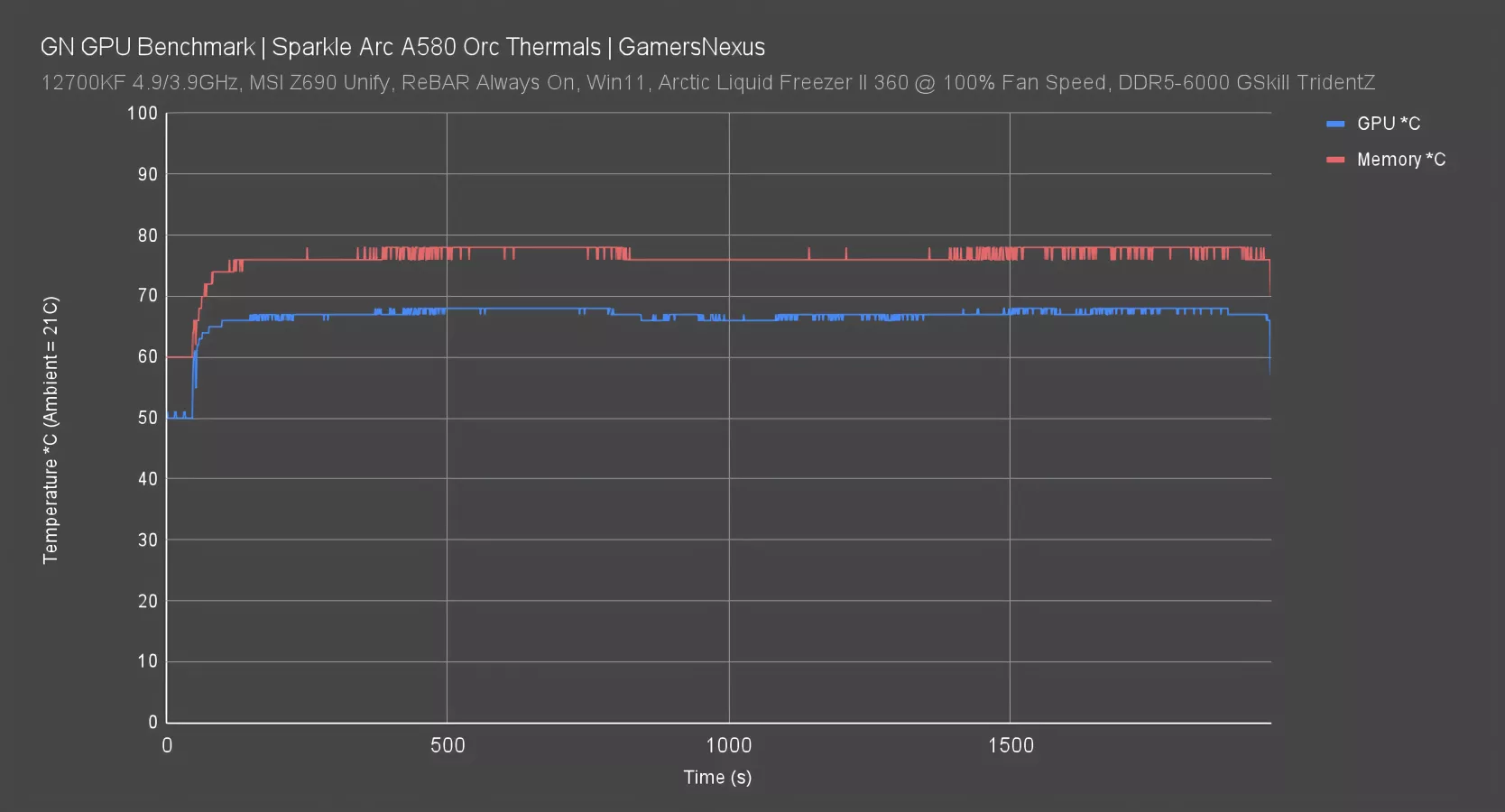
The A580 Orc ended up at about 68 degrees for the GPU core temperature when at steady state. There’s no problem with that. Even if your ambient were significantly higher than our 21C test environment, that’d still leave plenty of room. These lower-end GPUs tend to run relatively cool. Even in spite of the inefficient performance-to-power consumption we saw, the total power consumption remains more than manageable from a thermal perspective.
Thermals were about 78 degrees Celsius for the memory temperature. That’s well within spec. It’s warmer than we’d like to see on something like a 4090, which often has a massive heatsink, but that’s fine on a card like this one.
Intel Arc A580 Power Consumption
Load Power Consumption
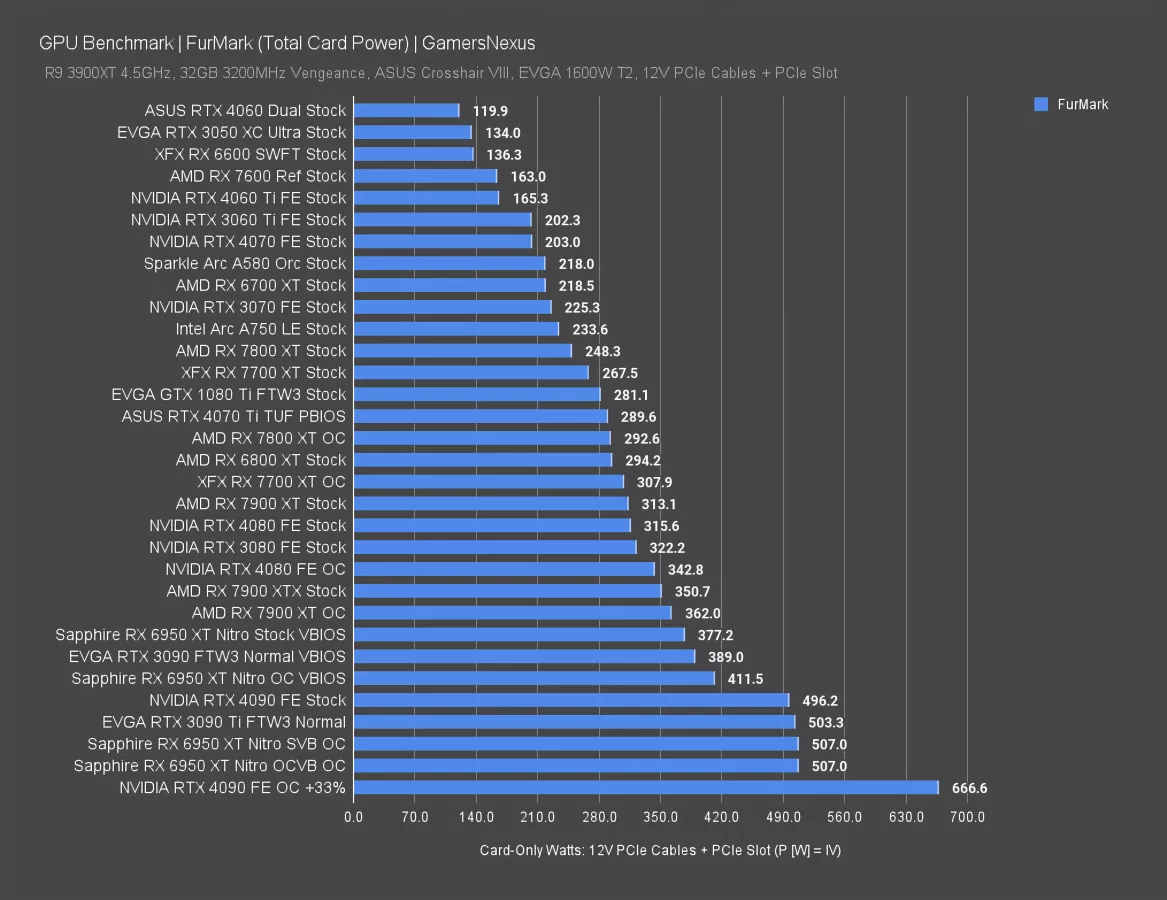
Testing the A580 for power consumption, we found that the card pulls 218W from the PCIe cables and the PCIe slot combined, making it one of the least power efficient cards we’ve tested anytime recently. The NVIDIA RTX 4070 blows it away for power-to-performance, as does Intel’s own Arc A750 card, which itself pulled 234W. The RX 6600 only pulled 136W in the same test, making it significantly more power efficient.
Intel has a lot of work to do on this front - it seems Intel is in AMD’s old habit from generations past, where it’s blasting power to keep up with competing hardware. Fortunately for Intel, at the lower-end, that’s not as limiting as at the high-end. But this is still Intel’s next most important area of improvement after driver support; as evidenced by Starfield, drivers are still a point of concern.
Idle Power Consumption
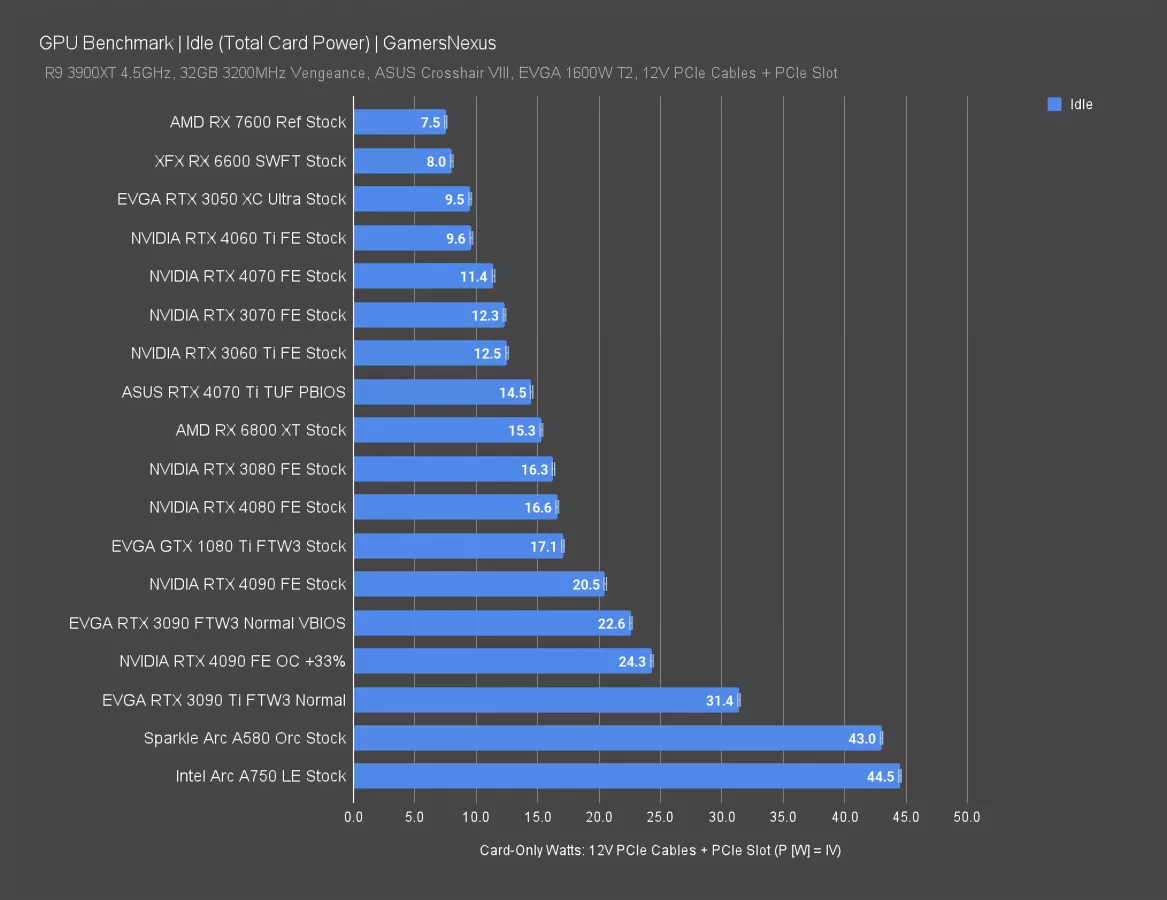
We normally don’t report on idle power draw, but that’s because it’s typically not interesting. In this truncated chart, we see the A580 was pulling 43W when idle on desktop. The A750 was at 45W. That’s a lot of heat for a passive computer. By comparison, the 4070 was around 11W here, with the RX 6600 at 8W.
For those wondering, this is a single-monitor setup. Multi-monitor setups sometimes cause different issues.
Conclusion: Whether the Intel Arc A580 is Worth It
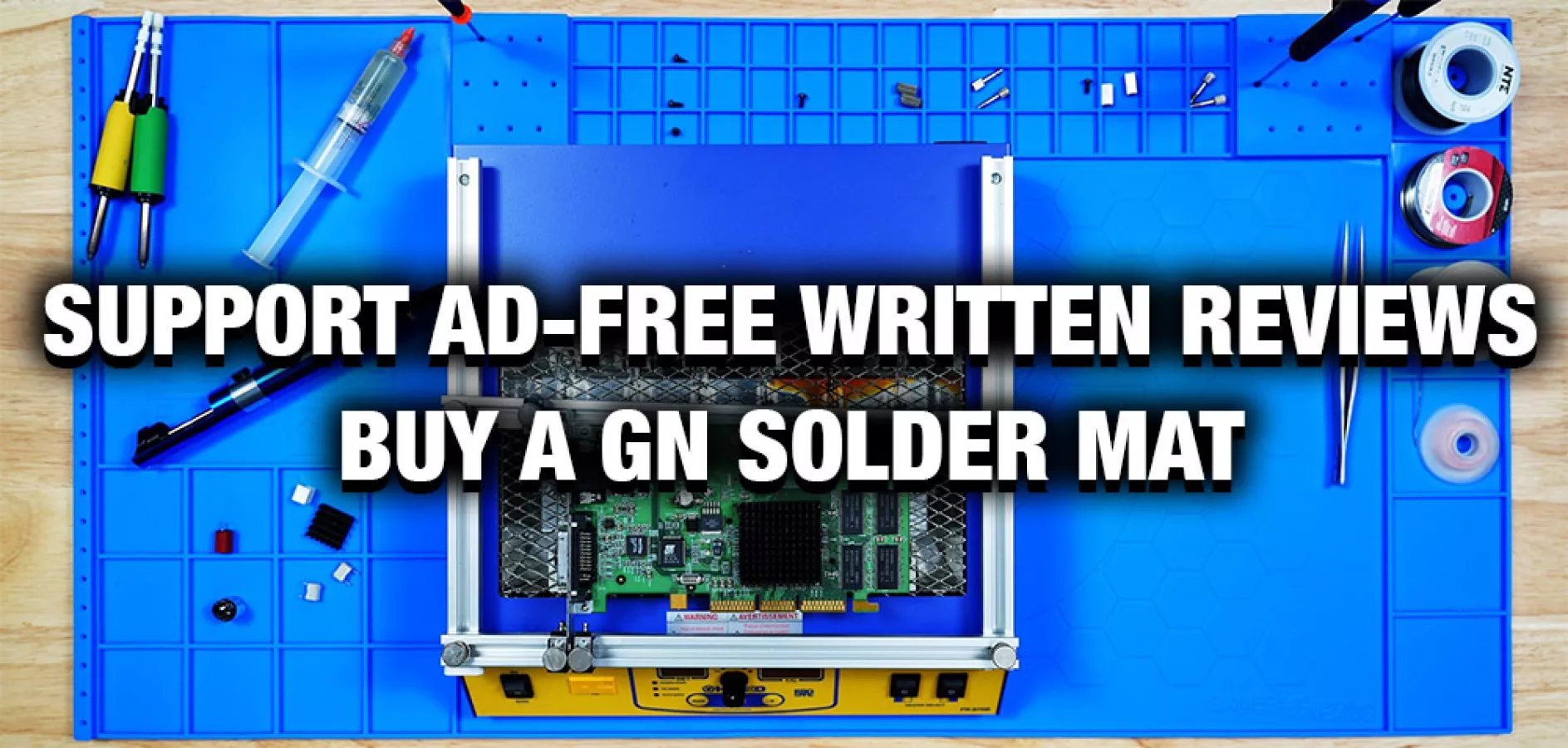
If it’s really a $10 difference and you’re set on Arc, definitely just go for the A750. It’s worth it over the A580, but both cards ultimately maintain the same disclaimer as noted at launch: Intel’s drivers. They’re getting better, and Intel is showing promise, but we still wouldn’t recommend one of these cards if you’re going to give it to someone who might not be able to troubleshoot independently. For alternatives, the AMD RX 6600 is a close competitor and the only one really strongly worth considering at the same price. NVIDIA presently has no meaningful options at this price range. Its last-gen RTX 3050 would fall sorely behind here, and an RTX 4050 hasn't yet been announced. The RTX 4060 is its closest modern option, but it's in a different price class. That card ends up around $300 currently, at which point you should also start considering the AMD RX 7600 (which is often cheaper by $50 or so).
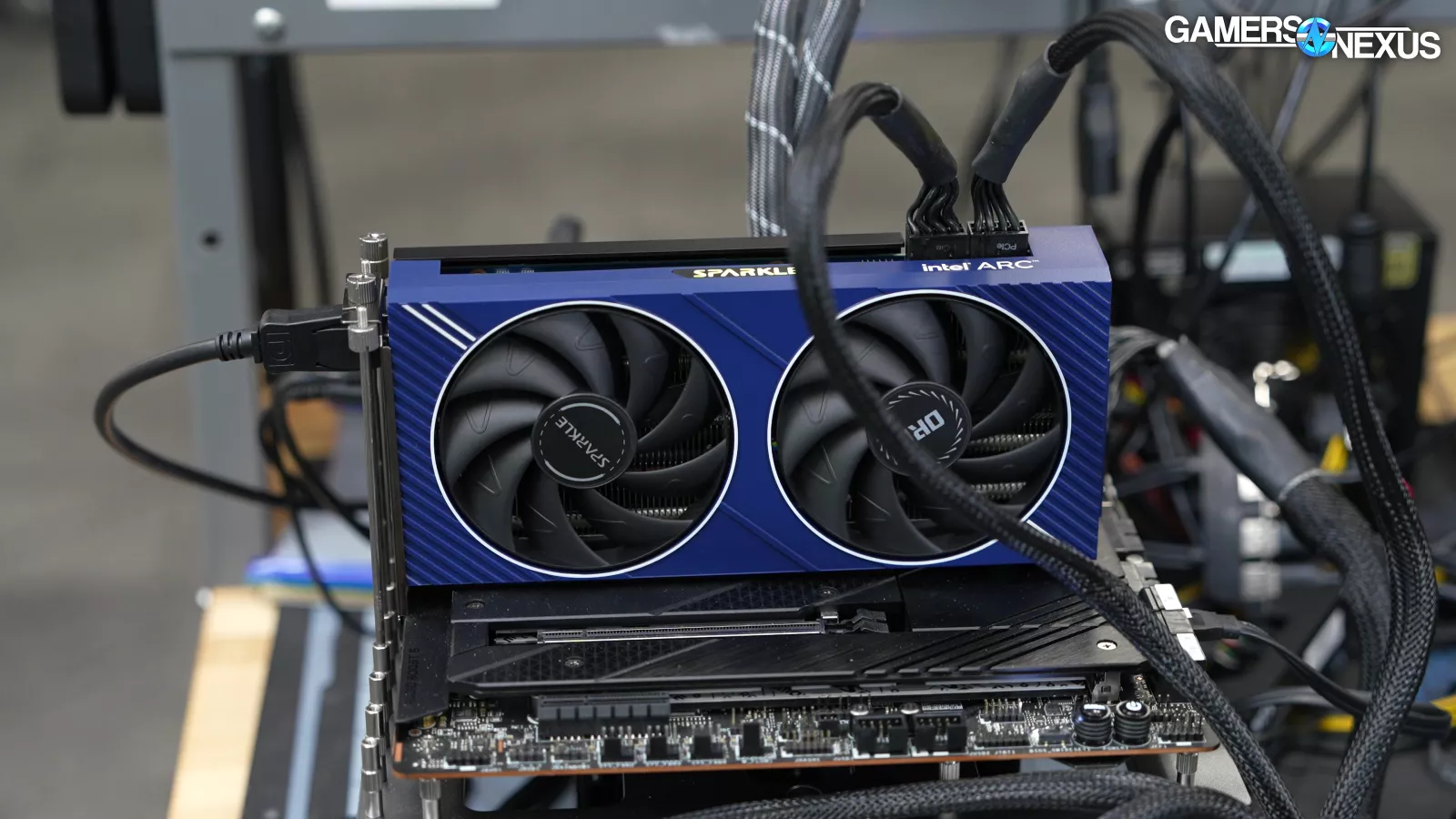
At least as far as Sparkle's execution of this card, the Orc model of the A580 is competent enough. It's fine for thermals, which is most of what they control. The card also doesn't pull that much power (in an absolute sense), so it's easy to keep cool. The power consumption in a relative sense, though, is wildly inefficient.


